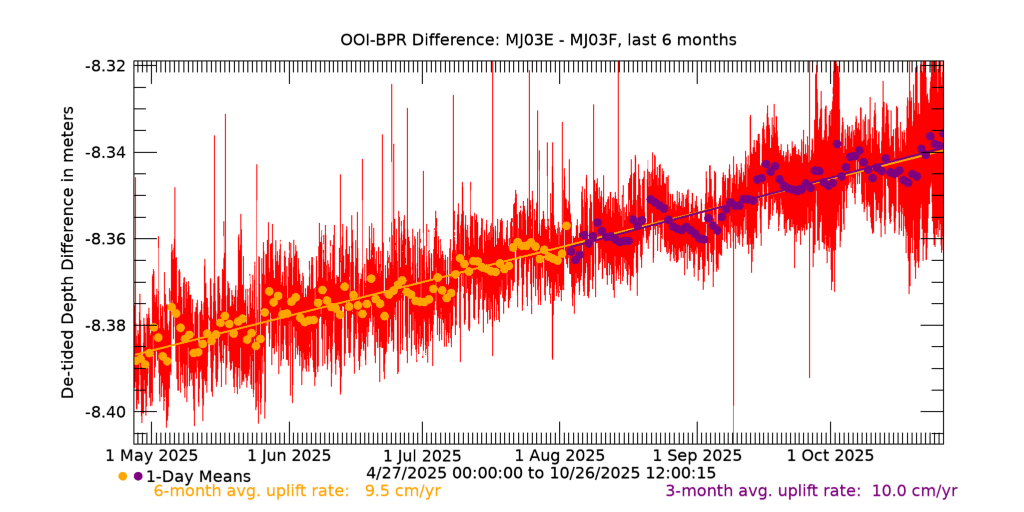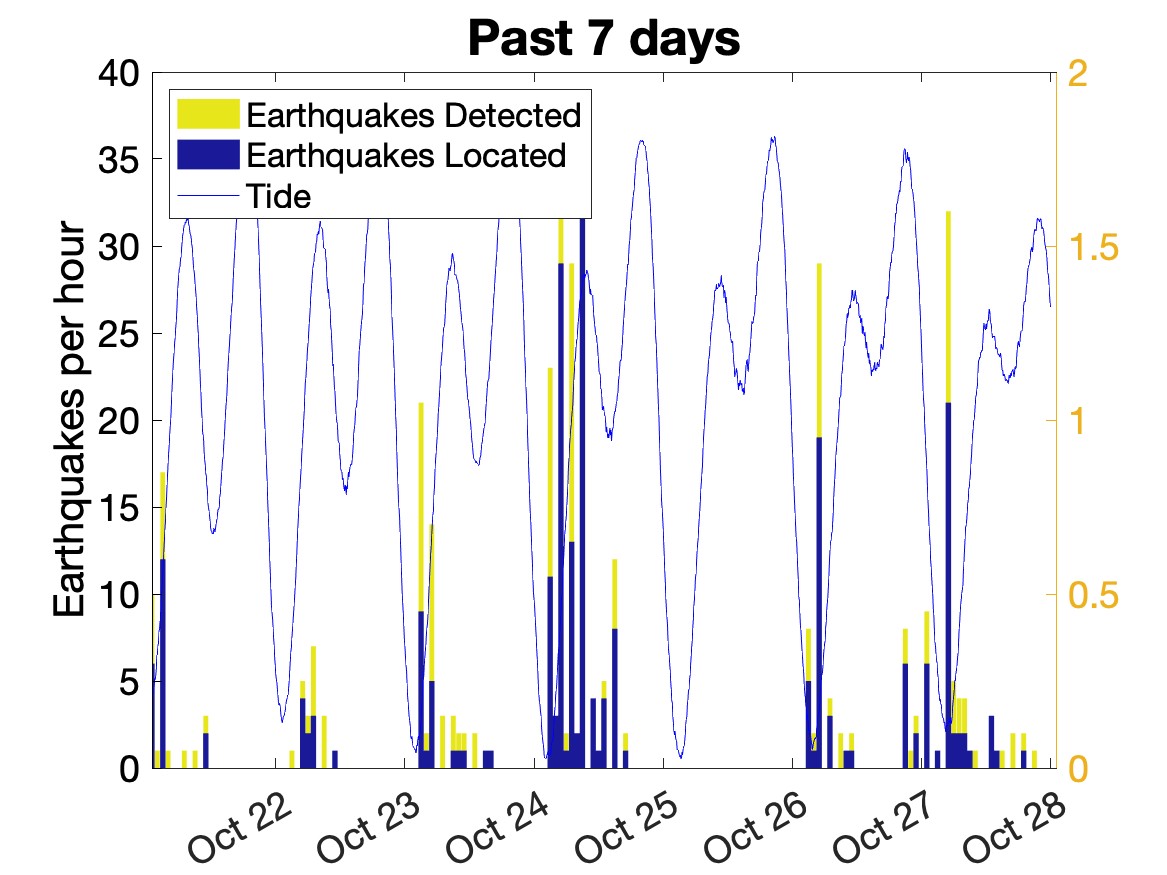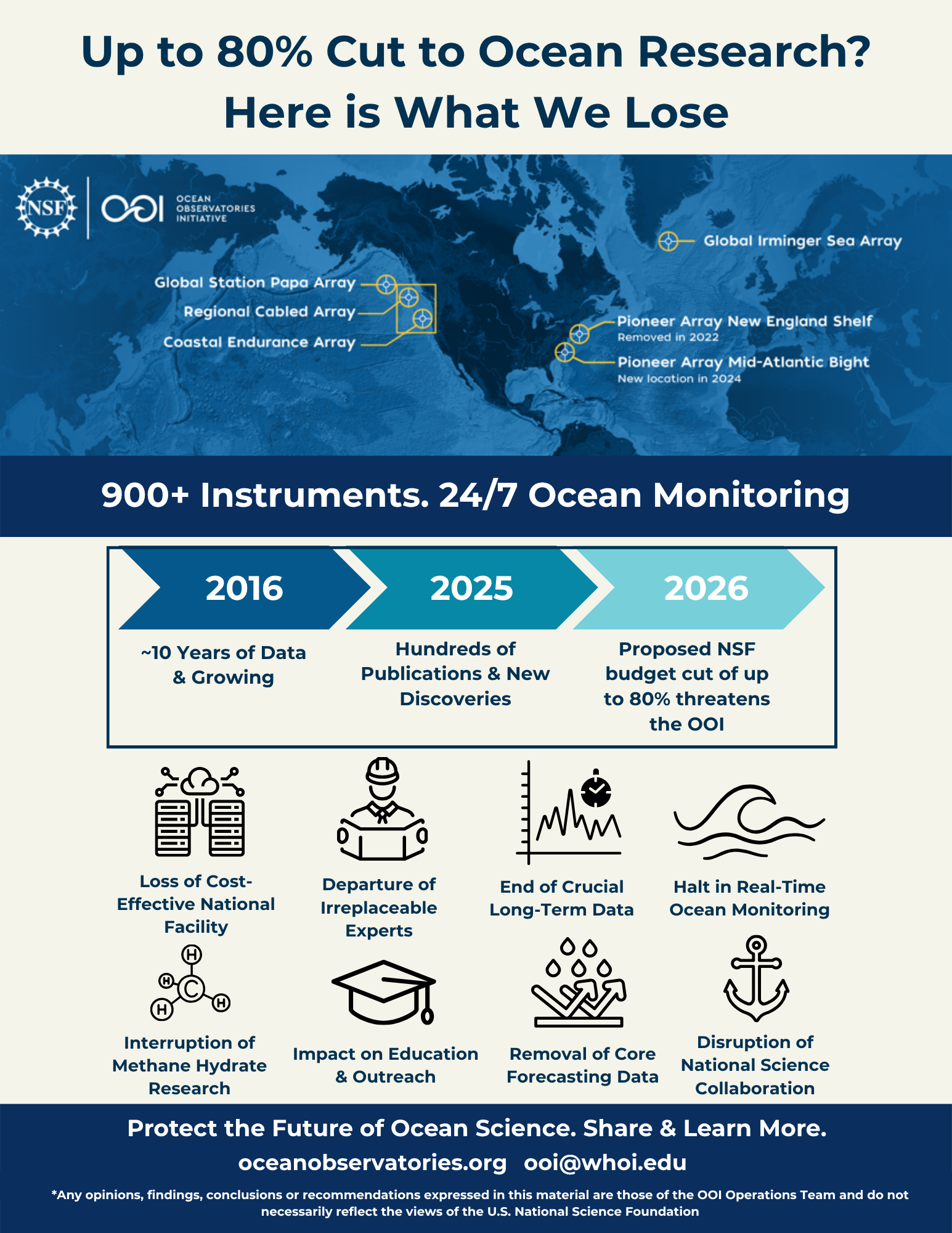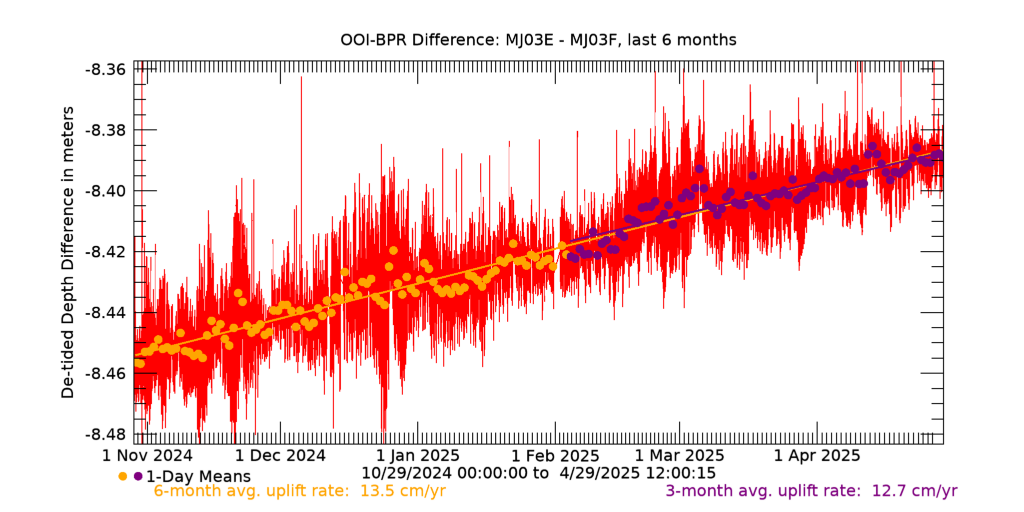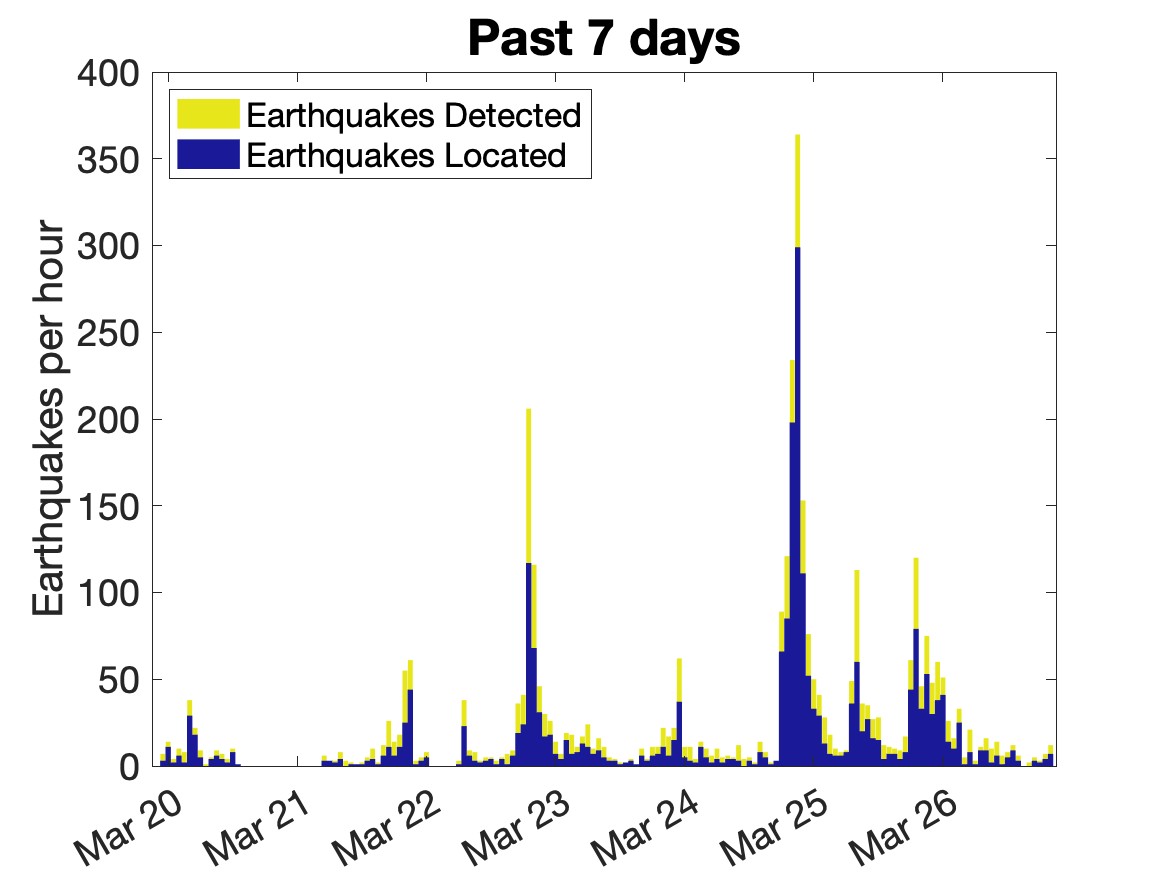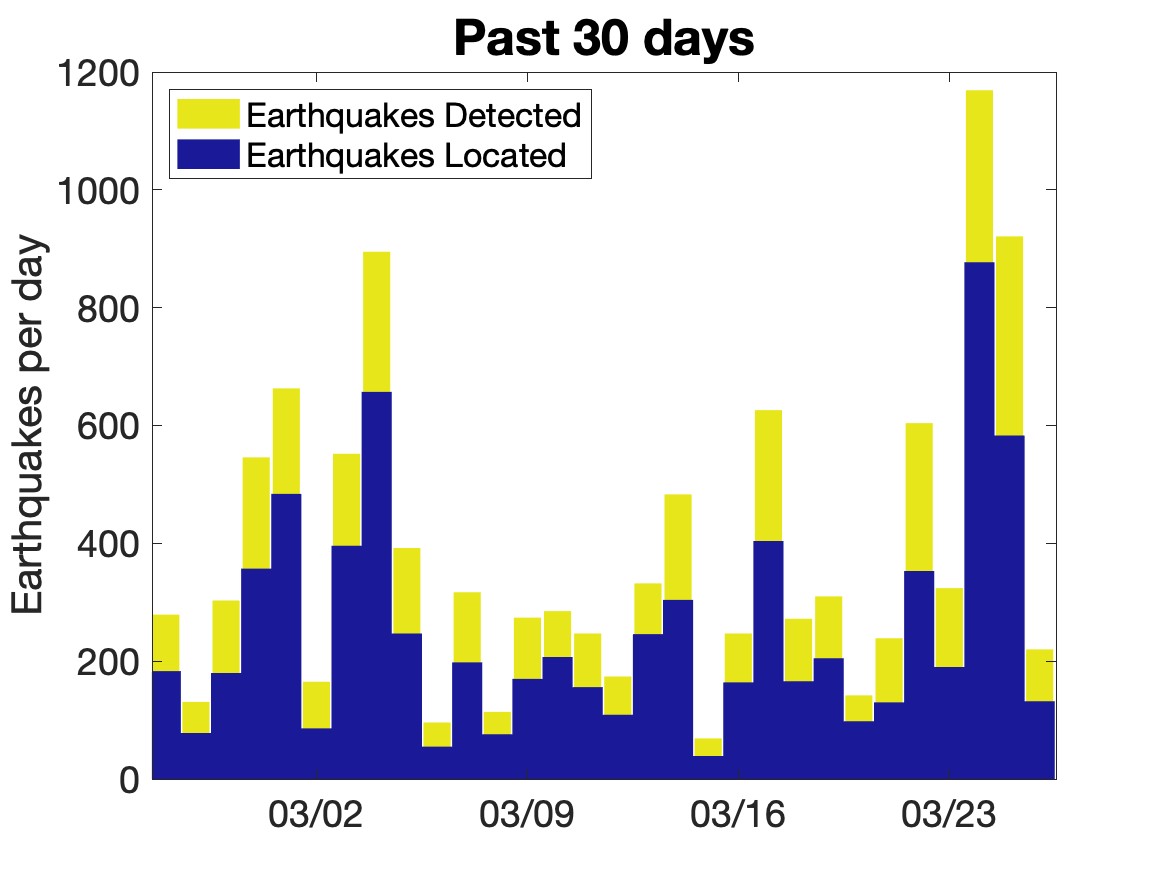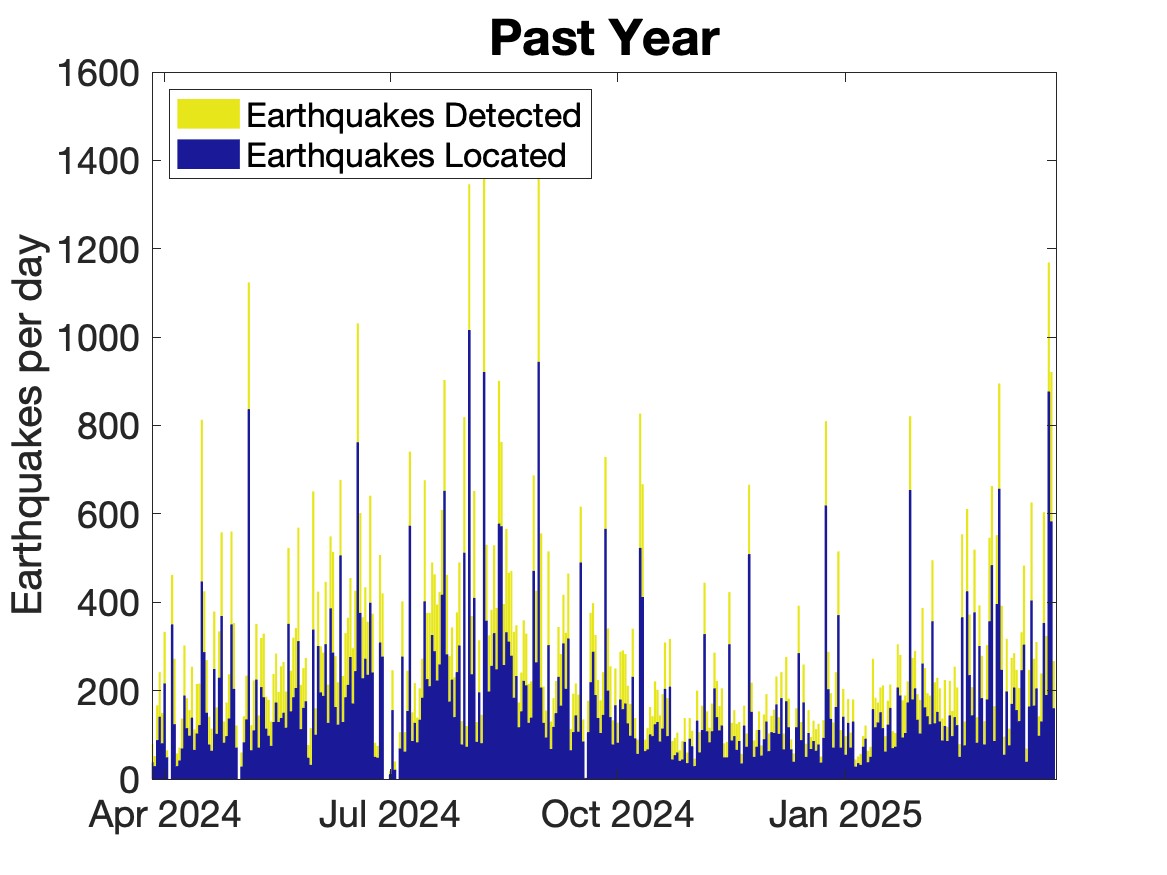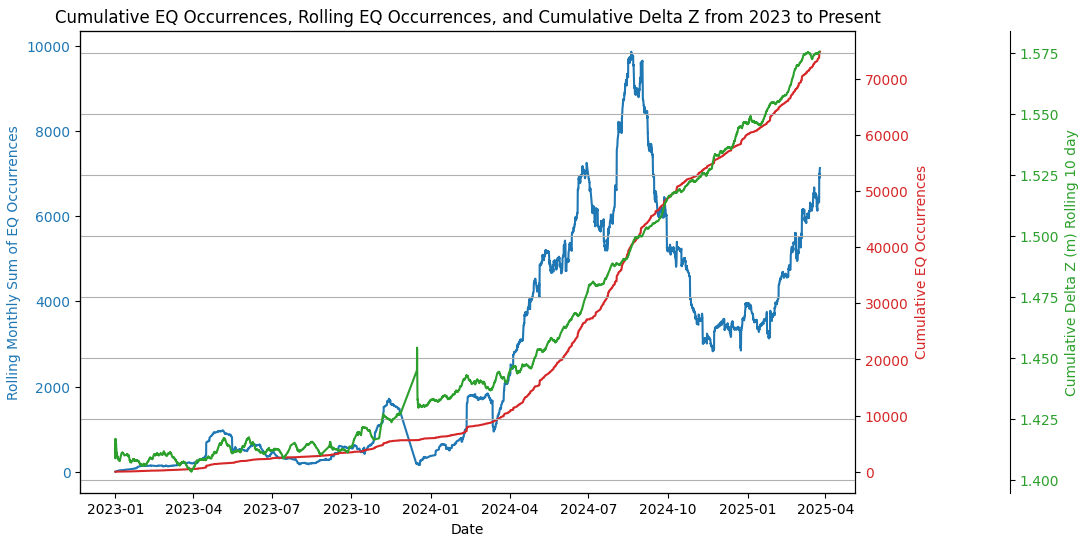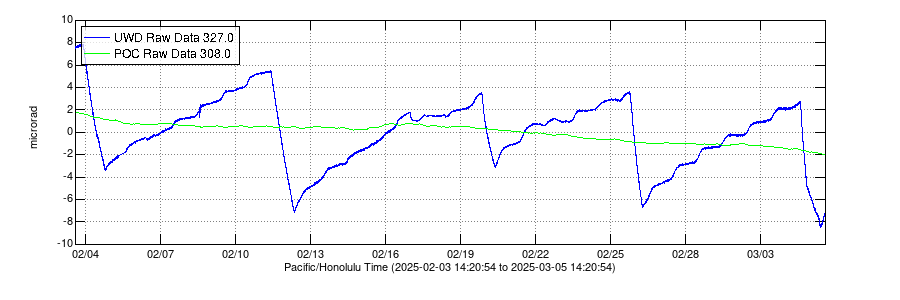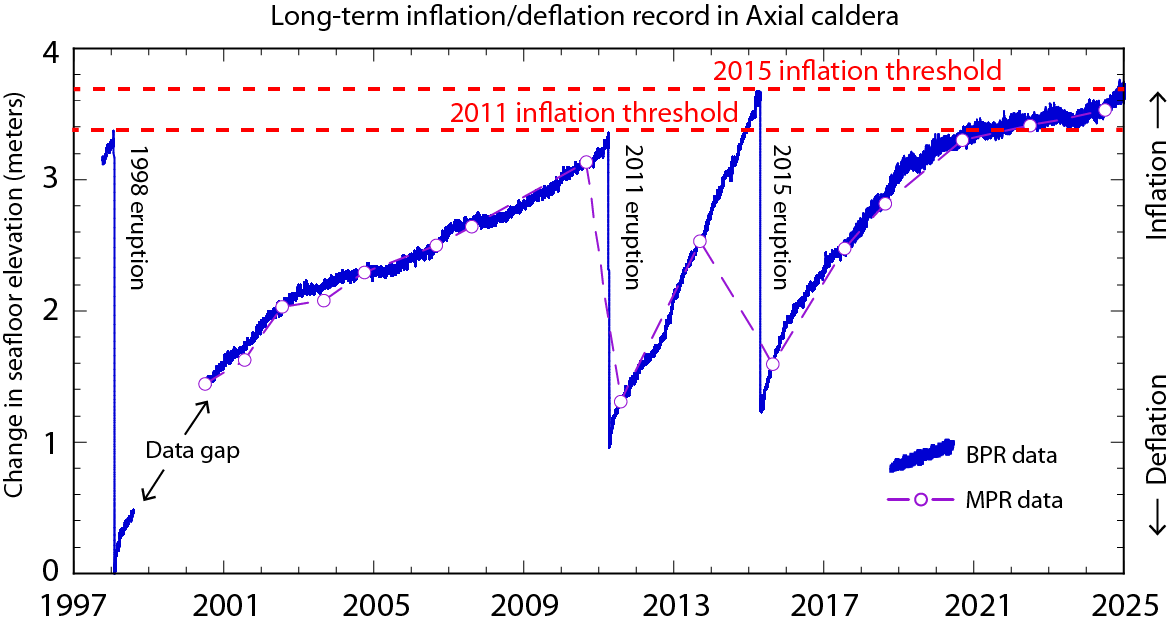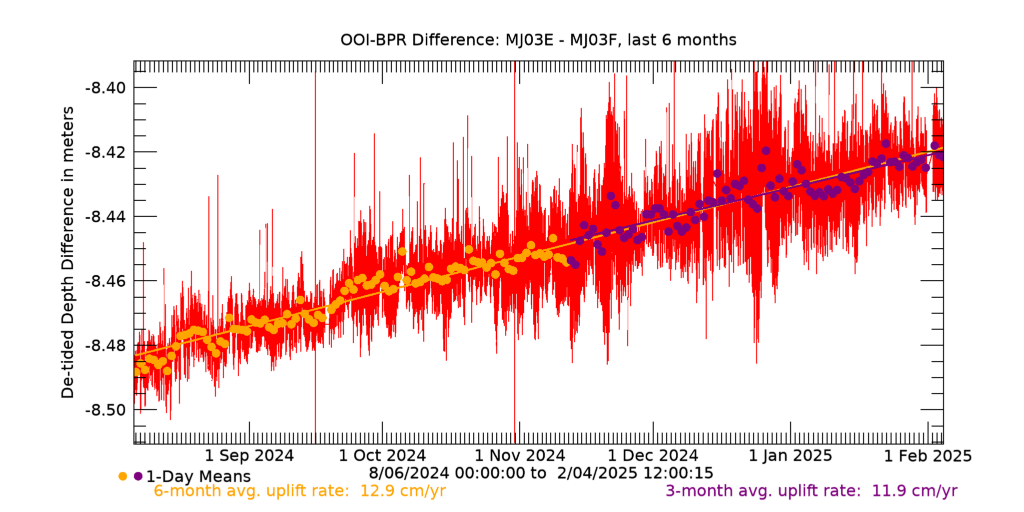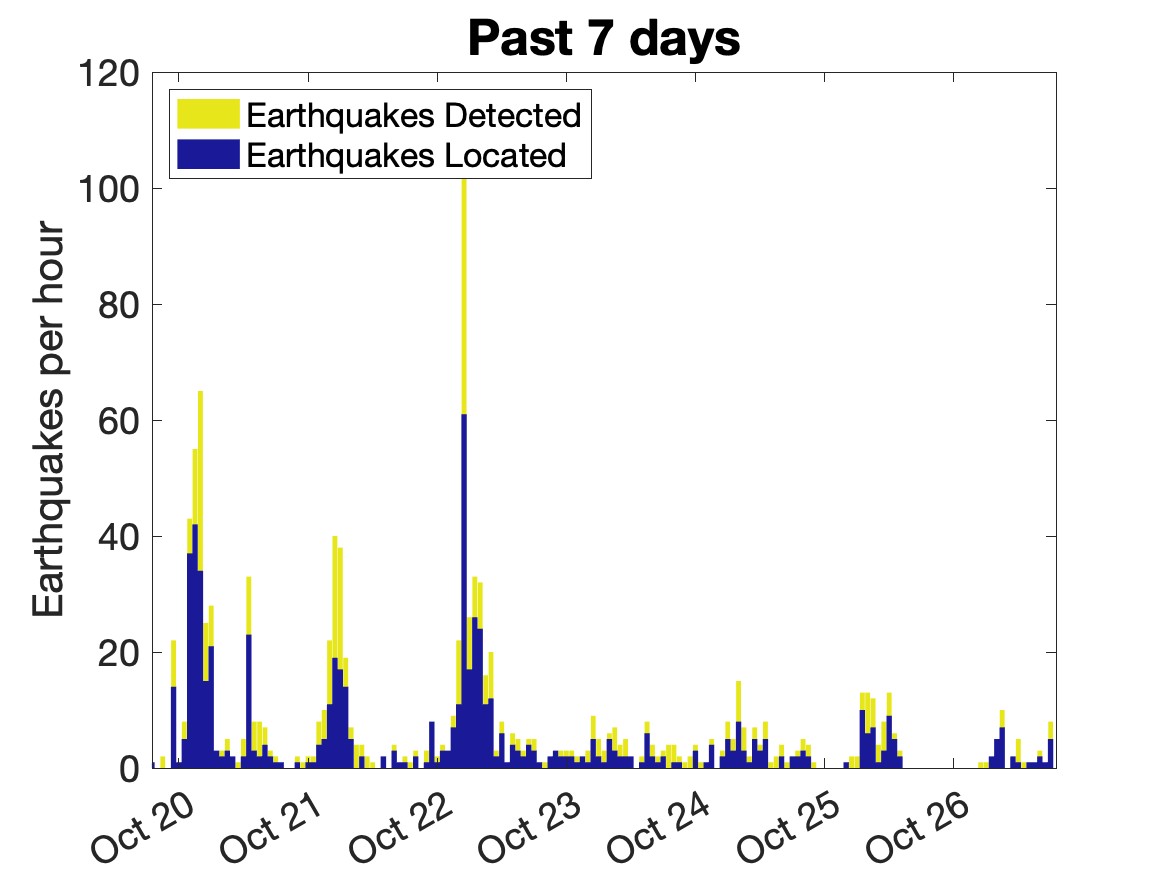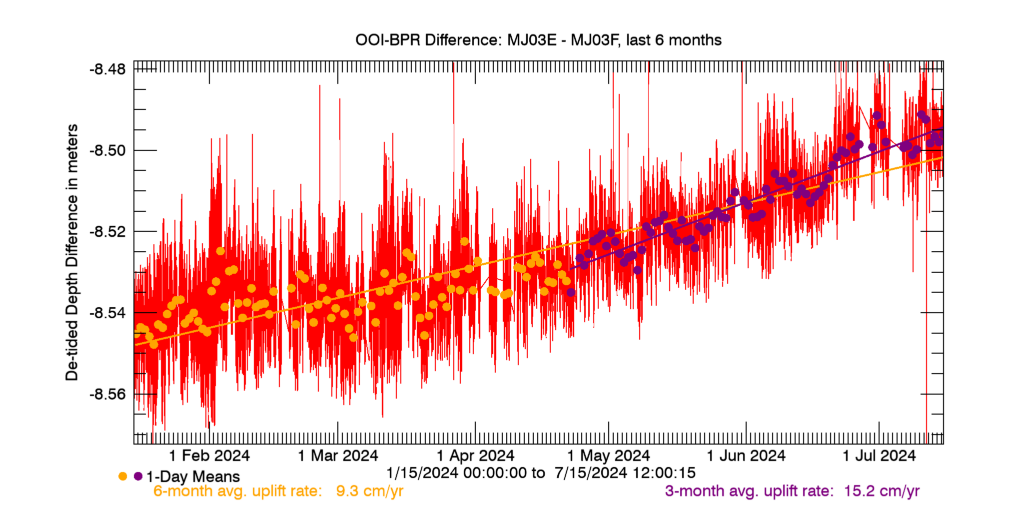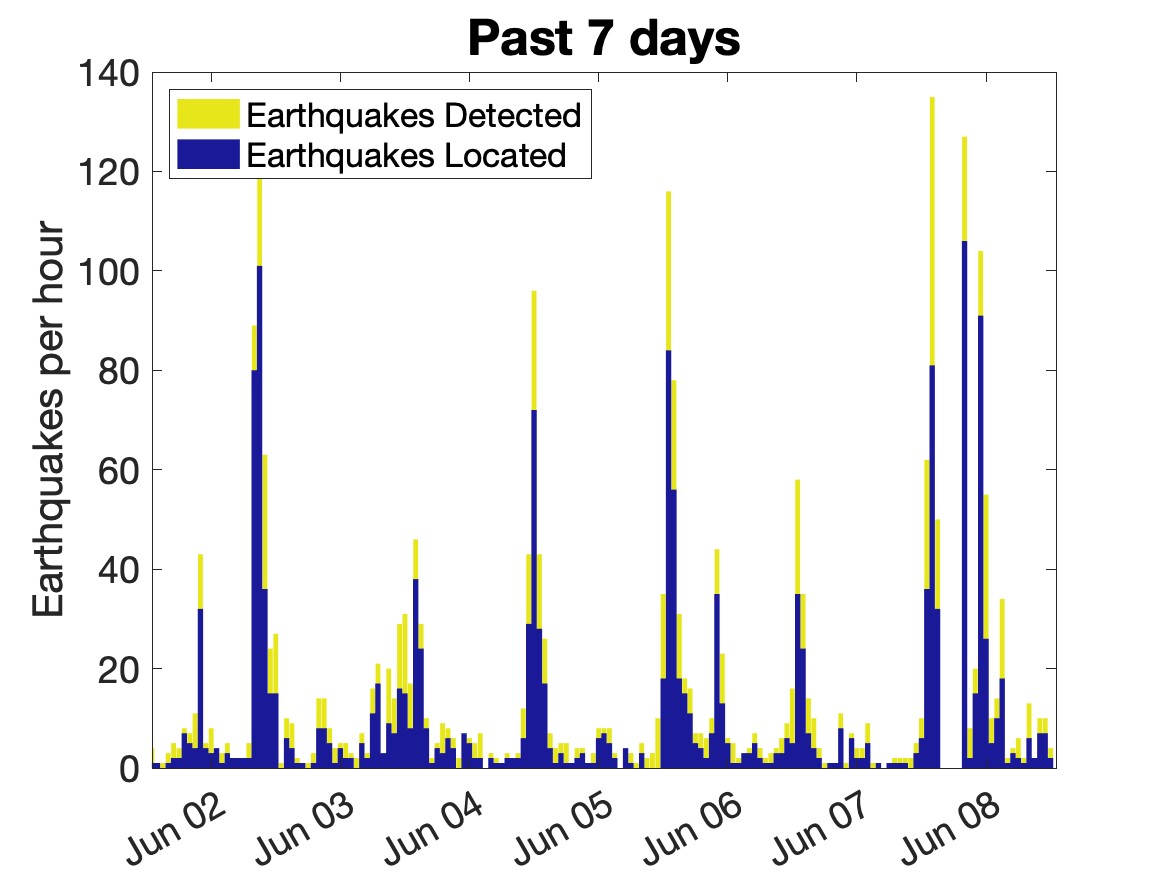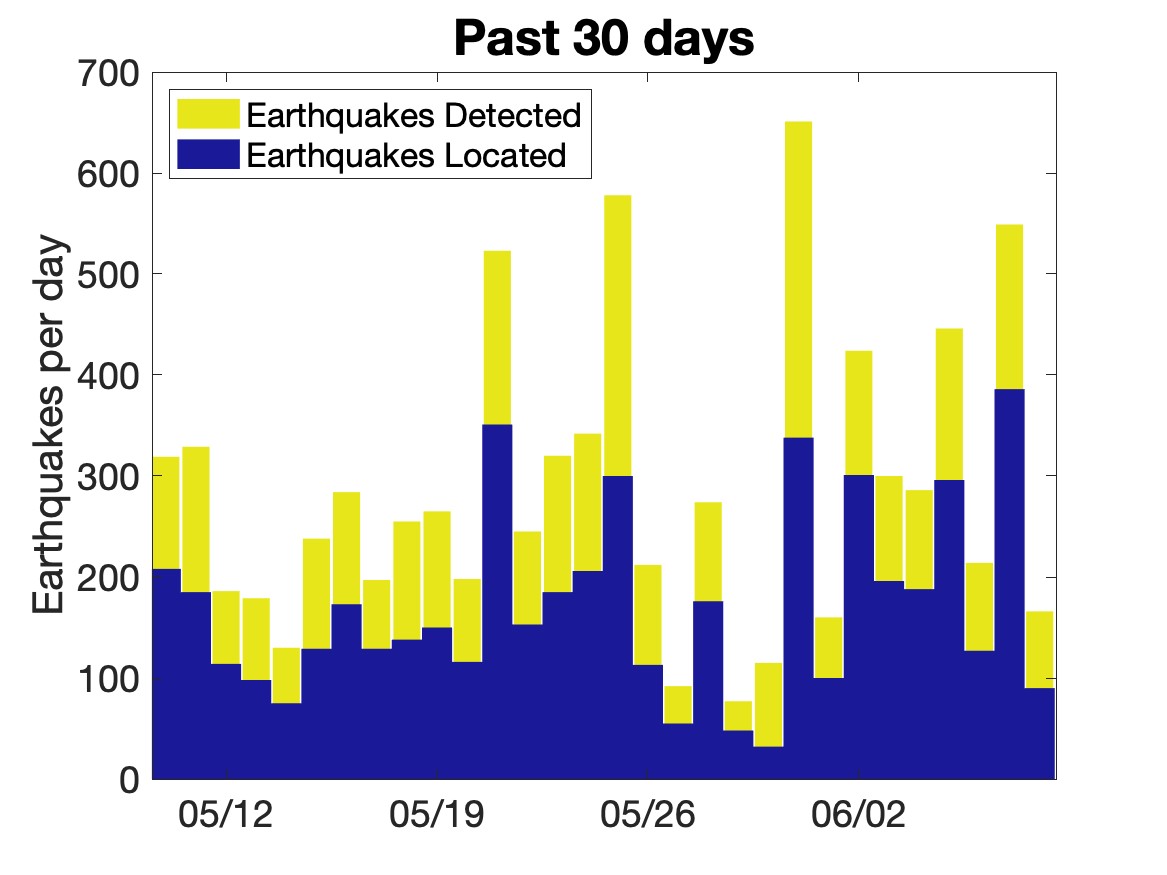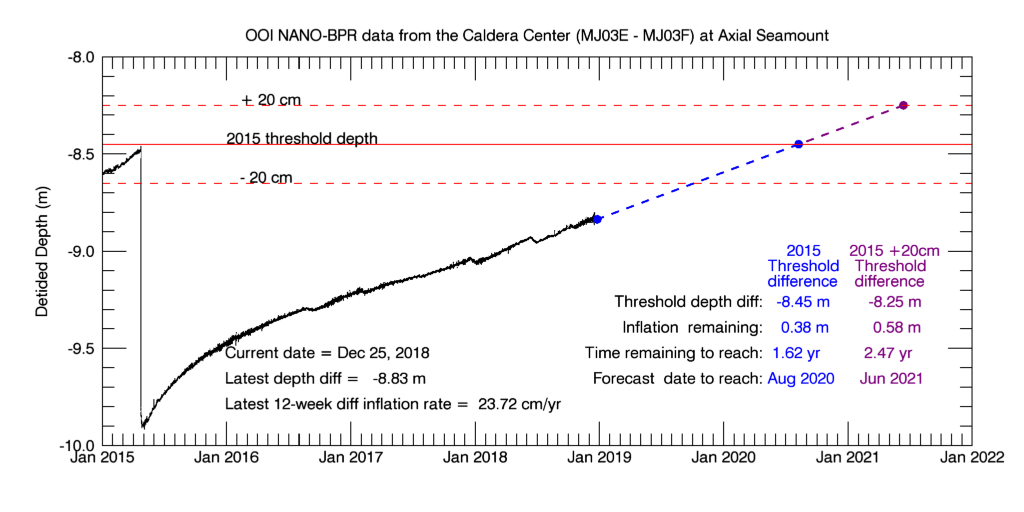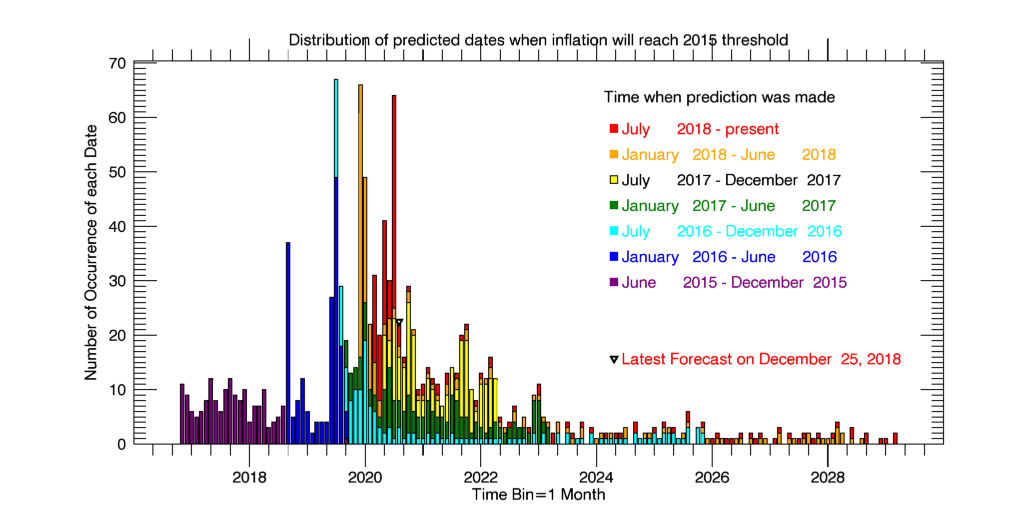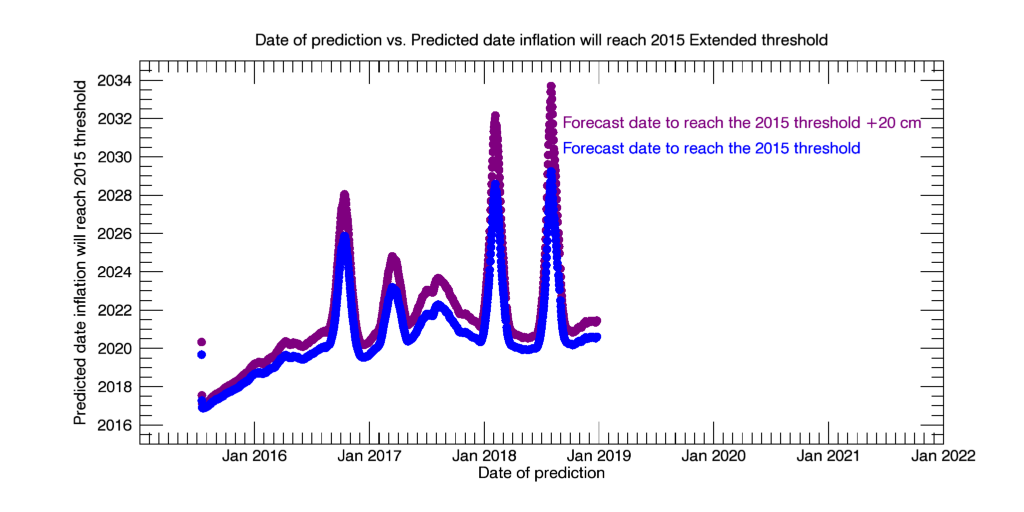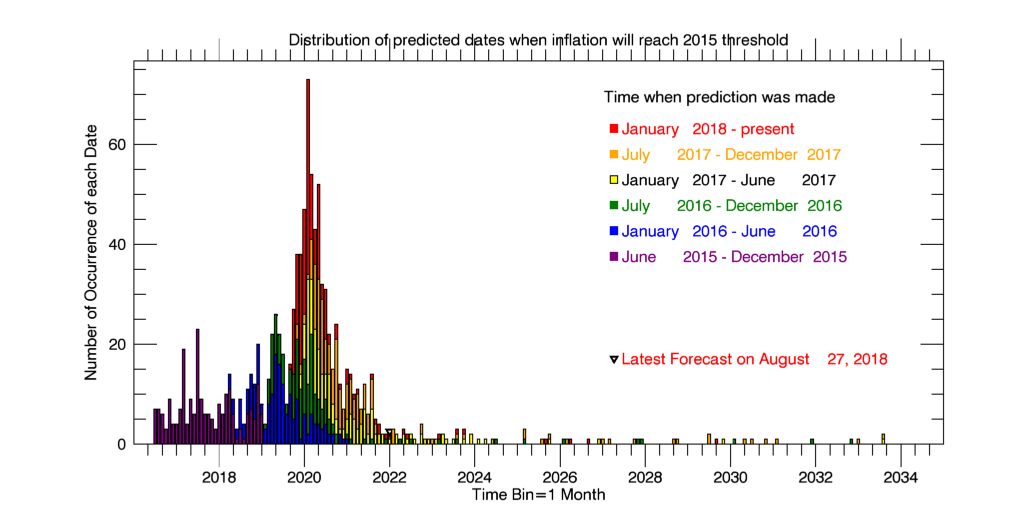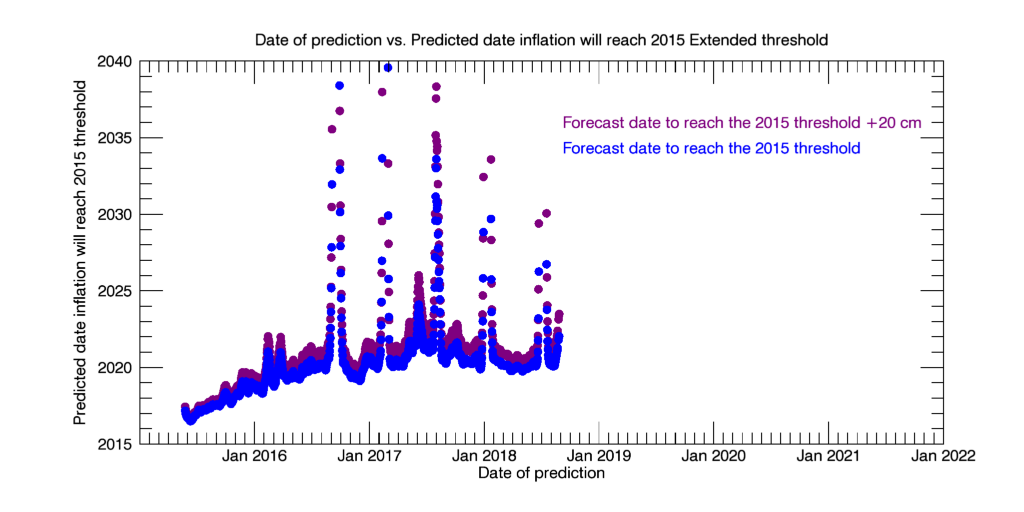Blog to chronicle eruption forecasts at Axial Seamount
Axial Seamount is the most active submarine volcano in the NE Pacific, with known eruptions in 1998, 2011, and 2015. It was chosen as the site of the world's first underwater volcano observatory called NeMO and is now a node on the OOI Regional Cabled Array. Here, we describe our attempts to forecast the timing of eruptions at Axial Seamount, based on the repeated pattern of ground deformation. This work is funded by the National Science Foundation. See plots of realtime data from the OOI-RCA -> HERE.
- Bill Chadwick (Oregon State University) & Scott Nooner (University of North Carolina at WIlmington)
November 12, 2025 - A new physics-based forecasting experiment begins this week...
A new experiment in eruption forecasting is starting this week using real-time data from the OOI Regional Cabled Array at Axial Seamount using a physics-based model developed by Qinghua Lei (Uppsala Univercity in Sweden) and Didier Sornette (ETH, Zurich, Switzerland).
They have developed a general model for forecasting mechanical failure in a variety of geologic settings: landslides, rockbursts, glaciers, and volcanoes. In a couple recent scientific papers they have shown that their model can predict the time of failure in retrospect - that is, when analyzing monitoring data that has already been recorded and after the failure event has already occurred (including with some of our past data from Axial Seamount). Starting this week, they are beginning a new experiment analyzing real-time OOI-RCA data from Axial Seamount (the uplift and seismic data) with their physics-based model to try to forecast the time of the next eruption. They plan to update the forecasts at least once a month, or more frequently, if warranted.
There is a general description of the experiment in a PDF file, here: http://arxiv.org/abs/2511.06128
... and on their geohazards website, here: https://www.geohazards-observatory.com/efe
Note, however, that they will not be making the actual forecast dates public until after the next eruption occurs, when they can assess the success or failure of the experiment. But after that, they plan to make all the forecasts public (whether they were successful or not). I'm very excited that they are willing to test their model with real-time OOI-RCA data from Axial Seamount, and I'm looking forward to seeing how well it works, particularly in comparison to our subjective attempts at forecasting, simply based on pattern-recognition (using no physics!), chronicled here.
October 27, 2025 - It's starting to feel like our latest eruption forecast is running out of time...
It's starting to feel like our latest eruption forecast (that Axial would erupt by the end of 2025) is running out of time. This is because, while the rate of inflation has remained pretty steady for the last year or so (at ~10 cm/yr in our recent differential-BPR plots, which is equivalent to ~16 cm/yr at the caldera center):
... that rate is a bit lower than the rate when we made that forecast, back in July 2024 (when the differential-BPR rate was ~15 cm/yr, or ~25 cm/yr at the caldera center):

... consequently, that also means that it will take a bit more time than we anticipated to reach the same inflation threshold that the volcano reached before the last eruption. The simple reasoning is this: the 2015 eruption was triggered at an inflation threshold that was 30 cm above the threshold at which the 2011 eruption was triggered:

... So we've been assuming that the next eruption might be triggered somewhere between the 2015 threshold and +30 cm higher. We are now about 10 cm higher than the 2015 inflation threshold, with perhaps as much as 20 cm more to go. But the slower the rate of inflation, the longer it will take to get there. It seems like every time we try to estimate when the volcano might get there, the rate of inflation changes, making our forecast incorrect. This has happened over and over since the 2015 eruption, and shows the obvious limitations of trying to make long-term forecasts based on simple pattern recognition: the pattern could change. At the current rate of inflation, we won't get to that higher inflation threshold until mid-to-late 2026. We'll wait until the end of the year to revise our forecast (who knows, it could still erupt before the end of the year!), but it's looking like we might have to add another year to our forecast window, based on the latest data.
While inflation has been pretty steady lately, the rate of seismicity has been relatively low, also contributing to that feeling that the forecast is running out of time and that nothing is imminent. Here are the latest earthquake histograms from the last week, month, and year from William Wilcock's and Maochuan Zhang's website at the University of Washington:
While there have been a few isolated days with over 1000 earthquakes in one day, on most days there are far fewer - more like 100 per day. For what it's worth, we had an on-line workshop focused on sharing recent research results from Axial Seamount earlier this month, and when polled most of the researchers at the workshop thought that Axial wasn't likely to erupt until next year, based on the latest monitoring data... more or less for the same reasons that we've articulated above. We shall see!
September 7, 2025 - A THIRD wave of media interest in our eruption forecast occurred last month...
In earlier posts (dated January 30 and May 20, 2025, below), I described two previous waves of media interest in our latest eruption forecast since a talk I gave at the American Geophysical Union meeting in December. The first wave of media interest ran its course and dissipated after a month or so. Then, even though nothing had changed, a second wave started in May, apparently sparked by a story that appeared on NBC News, followed by others on NPR News, USA Today, and the LA Times, among others.
Then in August, there was a THIRD wave of media interest, again even though nothing has changed! I'm not sure what spaked this latest one - maybe the fact that I reported that there had been over 2000 earthquakes in one day in the July 30 post, below. It started with a story that appeared in ABC News, followed by another on the website of the Portland, Oregon, Fox-12 TV (followed by a live-streamed interview on Fox-12 NOW), and even a story in People Magazine, among many others. Not surprisingly, the reporters who actually contacted me, asked questions, and fact-checked their stories wrote more accurate stories than the ones who just based their story on other reporting they found on-line, without checking anything. For example, the article in Yahoo! News got it right, that "nothing looks imminent" and "it won't pose a threat to humans", despite some of the other headlines:

It's hard to understand why this story has attracted so much attention, and why that interest has come in waves. So what's happening out there lately? Axial is still inflating fairtly steadily, although (as noted in the post on July 30, below) at a slightly reduced rate compared to July 2024, when we issued our current forecast that Axial would erupt by the end of 2025. The rate of seismicity has been relatively low lately (100-200 earthquakes per day), even though we had that one-day spike of over 2000 events about a month ago. So indeed, nothing looks imminent ...and it's starting to feel like our latest long-range forecast is running out of time.
Some context: This attempt at eruption forecasting is really an experiment to see if long-range forecasts (made months to years in advance) are possible at Axial Seamount. The experiment seeks to answer two questions: (1) Is the deformation pattern really repeatable from one eruption to the next, and are eruptions triggered at a similar level of inflation each time? The second question is: (2) How far in advance can we use that pattern to forecast the next eruption? Even if the answer to question #1 is "yes", the answer to this second question really depends on how steady the rate of inflation is with time, so we can use it to anticipate when the volcano will reach its critical inflation threshold. We were able to forecast the last eruption at Axial in 2015, 7 months in advance, largely because the pre-eruption rate of inflation was high and steady. However, since 2015, the rate of inflation has been highly variable, making long-range forecasting much more difficult and uncertain, and showing us that the volcano does not necessarily behave the same way leading up to each eruption. We won't know for sure until it erupts again, but we may be learning that even though Axial Seamount may have a repeatable eruption cycle (question #1, above), there are limits to how far in advance we can forecast its future behavior (question #2, above).
August 27, 2025 - The President's proposed budget for FY26 would devastate Ocean Observatories funding. Hopefully Congress will choose to save it.
The President's proposed FY26 budget for the National Science Foundation (NSF) includes an 80% cut in funding for the Ocean Observatories Initiative (OOI). The OOI includes the Regional Cabled Array (RCA), the cabled observatory that monitors Axial Seamount. We, of course, use real-time data from the OOI-RCA for our eruption forecast efforts, and a variety of other data from the OOI-RCA are used by us, our students, and many other researchers around the world to improve our understanding of how volcanoes work. Such a huge cut in funding to NSF and the OOI would be devastating in so many ways. We can only hope that Congress will choose to keep supporting the wealth of important scientific research funded by NSF and the OOI. The graphic below is from this article on the OOI website that describes what we would loose if the cuts are approved.
July 30, 2025 - The tsunami from the M8.8 Kamchatka earthquake triggered alerts at Axial Seamount
A magnitude M8.8 earthquake occurred last night in Kamchatka, on the other side of the Pacific Ocean. Soon afterward, we could see the ground motion from that earthquake show up on the tiltmeter sensors at Axial Seamount, thousands of miles away!

Then just before midnight (local time in Oregon), the tsunami waves from the earthquake began passing over Axial Seamount, and were measured by our bottom pressure recorders on the seafloor, and they triggered the automated alerts we have in place to notify us when an eruption might be starting at the volcano (but of course in this case, the large pressure changes were due to the tsunami waves passing by, rather than the seafloor rapidly subsiding during an eruption). Here's how the bottom pressure record looks this morning, with the tsunami waves arriving (six and a half hours after the earthquake) at the far right):

You can see the tsunami's effect is still churning up the ocean out there.
So what *IS* happening out at the volcano? Well, not much lately! The rate of inflation has been slowly decreasing all year. You can see from this plot:

... that the differential-BPR rate of uplift averaged over the last 6 months is 11.5 cm/yr (the equivalent of 19.2 cm/yr at the caldera center), whereas the rate averaged over the last 3 months is only 8.7 cm/yr (the equivalent of 14.5 cm/yr at the caldera center). That is down from differential uplift rates of ~15 cm/yr a year ago (the equivalent of ~25 cm/yr at the caldera center). Over the same time period, the rate of seismicity has also been waning. We had a spike of over 2000 earthquakes in one day back in June, but since then the number of earthquakes per day has been averaging only around 100 per day.
So what's happening out there? We can only wait and see, but nothing seems imminent at the moment since the rate of unrest keeps wavering up and down, up and down. Of course, we don't really know what it will take to trigger the next eruption and exactly when that will happen. But hopefully we'll learn more about that triggering process by the montoring we are doing now.
June 13, 2025 - How long will we have real-time data to monitor Axial Seamount?
Last Sunday, on World Oceans Day, the The Ocean Observatories Initiative (OOI) sent out an email to "recognize the ocean’s critical role in sustaining life on Earth" and to acknowledge how the OOI "has enabled transformative ocean science by delivering open, continuous, research-quality data from some of the most dynamic and remote marine environments." This of course includes the wonderful Regional Cabled Array in the NE Pacific, which is operated by the University of Washington and monitors the activity at Axial Seamount, on which this eruption forecast blog is based. However, the email continued... "But this World Oceans Day arrives with a tremendous amount of uncertainty."

The OOI and our own research on Axial Seamount are funded by the.National Science Foundation, which are now suddenly at risk, despite all our successes. Will we, as a country let this happen? Long live the NSF and OOI! Science is our candle in the dark!

May 20, 2025 - A second wave of media interest in our eruption forecasts ...
In an earlier post below (dated January 30, 2025) I described the first wave of media interest in our latest eruption forecast, after the talk I gave at AGU in mid-December. That first wave ran its course and dissipated after a month or so. Now, oddly and suddenly, a second wave of media interest has ignited. The second wave was apparently sparked by a story that appeared on May 8 on the NBC News website. Ironically, that reporter had interviewed me back in January, but the story apparently sat on the backburner for 4 months before it was finally published. But, because it was out of the blue and from a prominent media outlet, it gave the false impression that something had changed or that there was something imminent. The first story of the second wave was soon followed by another on May 15 on the NPR News website. Then, another reporter who had interviewed me in January, emailed to ask: "Is there anything new? Am I missing something?". I replied that no, nothing had changed in the story since January. But her editor insisted that she update the story anyway, which then appeared on the USA Today website on May 16, and acknowledged that little had changed since the original story on February 1. Amazingly, that story was read by over 75,000 people in the first 48 hours! Then today, an in-depth story was published on the LA Times website, and was even featured on the front page of the print edition! And now I'm fielding interview requests from a ship at sea on an expedition to explore the submarine volcanoes in the Mariana Trench Marine National Monument (you can still check out live ROV video during our dives until May 20 at nautiluslive.org). It's hard for me to understand why there is so much interest in this story. But perhaps its because it is not focused on all the other turmoil in our lives (at least if you live in the US). I know I feel a little farther from it all here in in the Mariana Islands...
April 30, 2025 - Inflation holding steady; number of earthquakes down a little lately...
From an email to OPB science reporter Jes Burns: It feels to me like Axial is just “treading water” lately. Inflation is marching along at a fairly steady clip (the 6-month average of 13.5 cm/yr in the differential BPR plot below is equivalent to a single-station-BPR rate of 22.5 cm/yr at the caldera center), but the rate of EQs is down a bit lately. We had a flurry of days with over 1000 eqs/day in late March/early April, but it feels like a bit of a lull since then (only a few 100 eq/day lately). EQ rates keep going up and down. I’d like it more if they were just going up and up and up! I think I’m getting a little impatient. I probably need to take some deep breaths and calm down! Still got 8 months to go before my latest forecast runs out of time. But sure doesn’t seem like anything is imminent…
However, some of us have joked that Axial Seamount is most likely to erupt when it is least convenient. And I'm about to run off to Guam to join a 3-week expedition of exploration in the Mariana Arc and Back-arc on the E/V Nautilus (if you're interested, you can follow along on their website HERE). So May is looking like a pretty inconvenient time for Axial to erupt ... so you never know!
As always, real-time OOI-BPR data plots are available HERE, and realtime OOI-seismic data are available HERE.
March 26, 2025 - Over 1000 earthquakes were detected yesterday at Axial!
We haven't seen that many earthquakes in a single day at Axial in a while (not since the summer/fall of 2024). The plots below show the numbers of earthquakes at Axial for the last week, month, and year from William Wilcock's and Maochuan Zhang's website.
Below is an updated plot that Jeff Beeson made comparing the uplift and earthquake rates since the beginning of 2023.
The earthquake data are from the catalog of Wilcock and Zhang at UW. The uplift data are the differential BPR data that we monitor at OSU. It's interesting how the rates have been oscillating and that the uplift and earthquake rates really track each other through the ups and downs. We're currently on a bit of an upswing, both in terms of the number of earthquakes per day and the rate of uplift.
March 9, 2025 - Eruption forecasting at Kilauea volcano, Hawaii - similarities & differences to Axial
Does the plot below look familiar?
It looks similar to this one, doesn't it? The one below is the long-term plot of inflation and deflation at Axial Seamount.
The first plot above shows tiltmeter data over the last month at the summit of Kilauea volcano, Hawaii, from the USGS Hawaii Volcano Observatory (HVO) website. The sharp downward trends are rapid deflation during lava fountaining episodes inside the summit caldera, and the upward trends are intervening periods of gradual inflation. The exciting part is that since this pattern has been somewhat regular and repeatable since this series of eruptions started in late December 2024, HVO has begun to issue "time windows of probability" for when the next fountaining episode is likely to start (basically mid-term eruption forecasts). And it's been working! For example, on February 28, 2025, HVO issued a Volcano Update that said they expected the next fountaining episode to start sometime between March 4-6 (see below).
And it started on March 4! Here's what it looked like (image from the HVO webcams):
USGS HVO describe how their forecasting method works in this January 10, 2025, Volcano Watch article.
Comparing Eruption Forecasting at Axial Seamount vs. Kilauea
There are some interesting similarities and differences between the forecasting methods being used at Axial vs. Kilauea.
SIMILARITIES
The similarities are that they are both are using a repeated pattern of surface deformation to forecast the volcano's future activity.
DIFFERENCES
Key differences include the following:
1) HVO is using the deformation data from Kilauea (tilt and GPS displacements) to model pressure changes in the shallow magma reservoir beneath the summit caldera. Their forecasts are based on when the model suggests enought pressure has built up to drive another episode of fountaining. At Axial, we only consider vertical displacements and do not employ a pressure model.
2) The time-scales are very different. The fountaining episodes at Kilauea are days to weeks apart. The recent eruptions at Axial have been 4-13 years apart.
3) Likewise, the forecast time-scales are different: at Kilauea, forecasts are issued days-to-weeks before eruptions, whereas we are trying to forecast eruptions months-to-years in advance at Axial.
4) The magnitude of the signals are also very different. The fountaining episodes at Kilauea are accompanied by 6-12 microradians of deflation (microradians are a measurement of tilt change). At Axial, the signals are much larger, with tilts of over 1000 microradians and subsidence up to 2.5-3.2 meters during co-eruption deflation.
5) The key forecasting parameter at Kilauea is the amount of inflationary tilt observed between previous fountaining episodes (6-12 microradians), and the modeled pressure build-up that that represents within the shallow magma reservoir. HVO uses the current rate of inflation to extrapolate into the future when that magnitude of inflationary tilt will be achieved, with respect to the end of the last episode. So, at Kilauea, it is the amount of inflation that is repeatable, not the level of inflation at which eruptions are triggered. At Axial, it is the opposite. Eruptions seem to be triggered at a repeatable inflation threshold, but the amount of deflation during eruptions, and the amount of re-inflation between eruptions, are both variable.
In any case, it is noteworthy that similar methods are being used with success at both volcanoes, and it will be interesting to continue to compare their development and effectiveness.
February 5, 2025 - An update on deformation and seismicity ... and a key distinction about forecasting
We issued our latest forecast (for an eruption by the end of 2025) in July 2024. In retrospect, that was near the height of the latest increase in activity, when the rate of inflation was up to ~15 cm/yr in our differential-BPR data (or the equivalent of ~25 cm/yr for single-station-BPR uplift at the center of the caldera), and the number of earthquakes per day was occasionally peaking at over 1000 events/day for the first time since the 2015 eruption. Since then, both the rates of inflation and seismicity have moderated somewhat. The current rate of inflation (averaged over the last 6 months in our differential-BPR data) is ~13 cm/yr (equivalent to ~22 cm/yr at the caldera center), so slightly reduced from July, but still substantial, and it has been relatively steady. The plot below is from HERE.
The decline in the rate of seismicity has been more pronounced (as monitored by William Wilcock and Maochuan Zhang at UW on their website: HERE), averaging ~100 located earthquakes per day, reduced from about ~200 last summer (and well below the ~400 per day seen before the 2015 eruption). The plots below show the numbers of earthquakes at Axial Seamount for the last week, month, and year from Wilcock and Zhang's website.
I would feel more confident of our forecast if the number of earthquakes were higher, and especially if the rate was increasing. But for now our forecast will remain as "before the end of 2025", because a lot can happen in the next 11 months. If the rates decline more, we may have to extend our forecast time window some more. We'll see.
A Key Distinction about Eruption Forecasting
In our forecasting, there are two key elements and it is worth distinguishing between them. The first is whether or not eruptions at Axial Seamount are really "inflation predictable". In other words, are eruptions at Axial really triggered at or near the inflation threshold from the previous eruption(s)? If so, that is truly remarkable and should enable long-range forecasting like we are attempting, which is generally not possible at most volcanoes on land. There could also be other factors we are not really considering, like has enough extensional stress accumulated since the last eruption to allow another seafloor spreading event?
The other element is actually making a forecast of a specific time window when the volcano will reach or exceed that inflation threshold, and so is likely to erupt. This forecasting of a time window can be tricky, because the rate of inflation can change after a forecast is made, and therefore change the outlook. This is what has happened since 2019 when we started to try to forecast when Axial would be ready to erupt again - we've had to repeately change our forecast window when the rate of inflation kept changing. So we can be right about the first element (that eruptions are inflation predictable), but we can get the forecasting of the timing wrong. Still, it will be remarkable if Axial continues its "inflation predictable" behavior, and if we get the time window wrong, we can always try to improve on that in the future. This is all an experiment and a learning experience. But hopefully we'll get them both right!
January 31, 2025 - Are you looking for a deep dive into our monitoring & forecasting at Axial Seamount?
If so, here are a couple videos you can view. The first is a recording of a hour-long talk I gave on November 14, 2024, at Oregon State University's Hatfield Marine Science Center. The title is "Axial Seamount is waking up! An update on the latest monitoring data and a new eruption forecast for this submarine volcano offshore Oregon".
Also available online is a 3-minute summary video of our last expedition to Axial Seamount in June 2024. The video was created by Marley Parker who went to sea with us. She also has a couple of blog posts about the cruise on her website: HERE and HERE.
January 30, 2025 - Science reporting about Axial Seamount: The GOOD, the BAD, and the UGLY.
Axial Seamount has been in the news a lot lately. What is going on? It all started when I gave a talk at the annual American Geophysical Union (AGU) meeting in Washington DC in early December. In contrast to my AGU abstract last year, in which I said Axial seemed to be taking a nap, in this year's AGU abstract I said that Axial had woken up in the intervening year and now seemed to be building up to its next eruption, and highlighting our latest forecast that it was likely to erupt "before the end of 2025." This interested a freelance science journalist, Rachel Berkowitz, who interviewed me, and then wrote a piece for Science News, which was published on December 27.
THE GOOD
This started a media snowball that is still growing, as multiple news outlets saw the Science News story (which was good), got interested in the story, and wanted to produce their own take on it. Another good story was written by Gosia Wozniacka and was published in The Oregonian/OregonLive on January 7, and then reprinted in the Seattle Times on January 9. Reporters from the main broadcast TV stations in Portland, Oregon, also contacted me to do their own stories or interviews, which were all generally good. In fact, all the reporters who have communicated with me (or Scott) have done a good job in their reporting, generally getting the facts right.
THE BAD
On the other hand, journalists who did not talk to me (or Scott) have generally gotten some of the facts wrong. A good example, is the story that appeared in Gismodo on January 3. First of all, any story about Axial that starts with how "it's gonna blow" raises a red flag. It's just not that kind of volcano, and it gives the wrong impression, trying to attract attention by being sensationalistic at the expense of accuracy. The article is not that bad until the last paragraph when it goes off the rails, making it sound like an eruption at Axial Seamount could be like the one in Tonga in January 2022, causing death and destruction. That is false and very misleading.
THE UGLY
Still worse is a story I saw today in Popular Mechanics. The headline is again that Axial is "about to blow", and the subtitle is: "Experts say an eruption between now and the end of 2025 is inevitable." INEVITABLE? This is probably a misunderstanding of my October 26, 2024 post below in which I said Axial was still inflating and that"it can't do this forever". But that doesn't mean it is certain that it will erupt this year! This shows no understanding of what we are trying to do at Axial. It is all very uncertain, and we are experimenting to see if long-term forecasts are possible here. Also misleading is the image at the top of the story that shows lava exploding at the sea surface, something that will never happen at Axial. The problem with bad reporting like this is that it propagates and begets more bad stories, misinformation, and misunderstanding. Here's hoping for better science reporting and fact checking...
October 26, 2024 - The rate of inflation at Axial has been steady for the last 6 months and the rate of seismicity has moderated. An eruption does not seem imminent, but it can't do this forever... So, no change in our latest eruption forecast of "before the end of 2025".
In the last blog post on July 17th (below), we noted that the rates of inflation at Axial appeared to be slowly increasing with time. Now, 3 months later, we can see that the differential rate of inflation has stabilized at about 15 cm/yr (see plot below from HERE), which is the equivalent of ~25 cm/yr at the caldera center.
The rate of seismicity (as monitored by William Wilcock and Maochuan Zhang at UW on their website: HERE) has moderated over the last 6 months, with rates of a few 100's of earthquakes per day. The plots below show the numbers of earthquakes for the last week, month, and year from Wilcock and Zhang.
Considering the fact that Axial is now essentially fully re-inflated, compared to the threshold reached before the 2015 eruption:
 . ... we still think the next eruption could happen any time between NOW and the end of 2025.
. ... we still think the next eruption could happen any time between NOW and the end of 2025.
Note the plots above are static. Realtime OOI-BPR data are available HERE, and realtime OOI-seismic data are available HERE.
July 17, 2024 - The rate of inflation at Axial keeps slowly increasing, so we need to adjust the forecast again. Now suddenly the next eruption looks like it could happen anytime between NOW and the end of 2025.
In the last blog post on June 8th (below), the rates of inflation at Axial had increased from an average differential rate of ~5 cm/yr over the previous 6 months to ~10 cm/yr in the previous 3 months. Now, just over a month later, the same rates of inflation have increased by 50%, to ~9 cm/yr and 15 cm/yr, averaged over the previous 6- and 3-months, respectively (see plot below from HERE).
The plot above shows the Differential Uplift between the OOI BPRs at the Eastern Caldera (MJ03E) and Central Caldera (MJ03F) for the last 6 months. Average rates of Differential Uplift are calculated for the last 6 and 3 months (in gold and purple, respectively). Correcting the Differential Uplift to the approximate real uplift at the caldera center (x 1.67) yields rates of 16 cm/yr and 25 cm/yr, for the last 6- and 3-months, respectively.
Extrapolating the lower rate would get us to the 2015 eruption inflation threshold in January 2025. Extrapolating the higher rate gets us to the threshold in November 2024! That said, the earthquake rates are not yet as high as we saw in the months leading up to the 2015 eruption (1000's of earthquakes per day), but that may be because the current rate of inflation (15-25 cm/yr) is much lower than it was then (60-90 cm/yr).
We can compare the seafloor uplift data to the number of earthquakes detected at Axial (as monitored by William Wilcock and Maochuan Zhang on their website: HERE), and also by Kaiwen Wang and Felix Waldhauser on their website: HERE).
The plot above of uplift and seismicity at Axial since 2017 was made by Jeff Beeson (OSU), using OOI differential BPR data in blue (from HERE) and the cumulative number of earthquakes detected in red (from the OOI seismic data catalogue HERE). The plot emphasizes the dramatic increase in both the rate of uplift and earthquakes at Axial since the beginning of 2024.
Considering all of the above, and especially the fact that the rates of uplift and seismicity seem to be increasing rapidly, and the fact that we are between 93-98% re-inflated compared to the pre-eruption threshold in 2015, I am now thinking that the next eruption could happen any time between NOW and the end of 2025. So that's my updated eruption forecast window (1.5 years wide).
I must admit, it is a bit of a shock how fast the outlook has changed at Axial. A year ago, I was wondering if Axial was napping and if it would EVER erupt, since the rate of inflation had decreased to near-zero. Now, just a year later, it has clearly woken up and is even feeling "frisky"!
Again, just to remind everyone, all my forecasts since the 2015 eruption have been WRONG, because of the constantly changing rate of inflation during that time. But I view this as a learning experiment in eruption forecasting, and I feel it is more honest to make public (and uncertain) forecasts before something happens, rather than after the fact with 20-20 hindsight.
Note the plots above are static - they were created in mid-July 2024. Near-real-time OOI-BPR data are displayed HERE, and near-real-time OOI-seismic data are displayed HERE.
June 8, 2024 - The rate of inflation at Axial has almost doubled in the last 6 months and seismicity is picking up. Time for a new forecast!
The rate of inflation at Axial has been slowly, but consistently, increasing in the last 6 months, from an average differential rate of ~5 cm/yr to ~10 cm/yr (see plot below from HERE).

The plot above shows the Differential Uplift between the OOI BPRs at the Eastern Caldera (MJ03E) and Central Caldera (MJ03F) for the last 6 months. Rates of Differential Uplift are calculated for the last 3 and 6 months (purple and gold, respectively). Correcting the Differential Uplift to the approximate real uplift at the caldera center (x 1.67) yields rates of 10.8 cm/yr and 17.4 cm/yr, respectively.
The rate of seismicity (as monitored by William Wilcock and Maochuan Zhang on their website: HERE) has also been increasing in the last 6 months, and is now at rates of 100's of earthquakes per day. There are peaks of earthquakes at the low-tide each day, which is also a sign that the system is getting increasingly stressed. The plots below are numbers of earthquakes for the last week, month, and year from Wilcock and Zhang.
Comparing this to the build-up to the 2015 eruption, after the OOI Cabled Observatory came on-line in November 2014, suggests we may be getting close to being in a comparable build-up stage (the figure below is from Wilcock et al. 2016).

Extrapolating the average rate of uplift from the last 6 months forward in time, looks like this (from HERE):
...or if we use the higher rate from the last 3 months, it looks like this (from HERE):
So, if the current rates of uplift continue (and that's a big "IF", since they have been highly variable since the 2015 eruption), then this suggests that Axial will reach its 2015 inflation threshold sometime between January to June 2025, and the +20 cm higher threshold between December 2026 and June 2028. If the rate of inflation continues to increase, it could be sooner.
With rates of inflation out of the doldrums, and the rates of seismicity increasing, it now seems possible to forecast an eruption window again. Based on the current rates, I would expect Axial to erupt again sometime in either 2025 or 2026 (a 2-year window, for now). As before, if the rates change, we'll have to revisit this forecast. And I admit that all my forecasts made since the 2015 eruption have been wrong, because of the multiple times that the inflation rate has changed over this time. But this is a learning experiment in forecasting, so I'm going to continue to make forecast attempts, undaunted (and I feel it is more honest to do so before something happens than after the fact with 20-20 hindsight).
Note the plots above are static - they were created in early June 2024. Near-real-time OOI-BPR data are displayed HERE, and near-real-time OOI-seismic data are displayed HERE.
Janurary 3, 2024 - Axial inflation is picking up slightly over the last few months...
The rate of inflation at Axial seems to have picked up slightly in the last few months (since about October 2023). I figure it's because of my AGU iPoster that said that inflation had more-or-less stopped and wondered if Axial was taking a nap (see blog post below and AGU iPoster archived HERE). Indeed, the rate of inflation over the summer was the lowest we've seen and only slightly positive (~1-2 cm/yr). But over the last 6 months the average differential rate of inflation is ~4.5 cm/yr, and over the last 3 months it's 6.4 cm/yr (see plot below from HERE).

Above is a plot of Differential Uplift between the OOI BPRs at the Eastern Caldera (MJ03E) and Central Caldera (MJ03F) sites for the last 6 months. Rates of Differential Uplift are calculated for the last 3 and 6 months (purple and gold, respectively). Correcting the Differential Uplift to the approximate real uplift at the caldera center (x 1.67) yields rates of 7.5 cm/yr and 10.7 cm/yr, respectively.
The uplift rate for the single-station OOI BPR at the caldera center (MJ03F), which is noisier and has some data gaps, more or less agrees with a rate of 12.3 cm/yr over the last 3 months (see plot below, from HERE).

These rates of uplift are still historically low, but at least Axial seems to be getting out of its recent "stupor". The rate of seismicity (as monitored by William Wilcock and Maochuan Zhang HERE) is also relatively low, but nevertheless has shown a slight increase since October 2023, as shown in the plot below (note there is a data gap in the plot from Nov 26 to Dec 16).
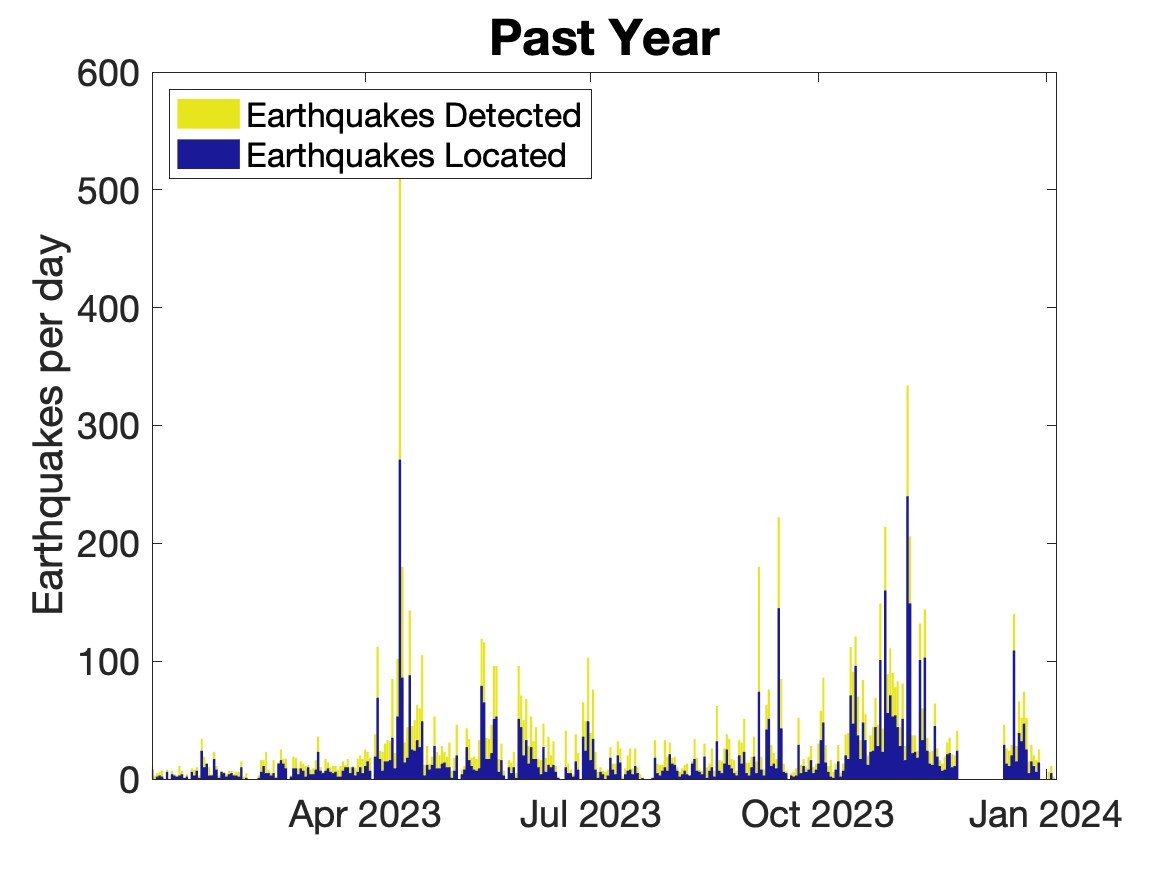
So, we'll have to see if these rates of uplift and seismicity continue ... or whether they increase ... or decrease. You can see for yourself by checking near-real-time OOI-BPR data are displayed HERE, and near-real-time OOI-seismic data are displayed HERE.
August 23, 2023 - Inflation at Axial has essentially stopped ... is Axial napping?
The following is an Abstract for a Poster presentation at the American Geophysical Union meeting in San Francisco, Dec 11-15, 2023. The authors are: William W. Chadwick, Jr., William S. D. Wilcock, Scott L. Nooner, Jeff W. Beeson
Axial Seamount is a submarine basaltic hotspot volcano superimposed on the Juan de Fuca Ridge. It has had a continuous but variable magma supply since systematic inflation monitoring began with bottom pressure recorders in 1997. Three observed eruptions since then suggest the volcano erupts at a similar level of inflation each time. Since the last eruption in 2015, Axial has re-inflated to ~94% of its previous threshold. However, the rate of inflation has gradually decreased from >100 cm/yr to <10 cm/yr, and as of August 2023, inflation has essentially stopped. Inflation is monitored in real-time by a network of tilt and pressure sensors on the NSF-funded Ocean Observatories Initiative Regional Cabled Array (OOI-RCA).
Similarly, the rate of seismicity (also monitored by the OOI-RCA) is currently at relatively low levels of ~10/day, compared with a rates of ~1000/day in the months leading up to the 2015 eruption. Right after the 2015 eruption, the rate of earthquakes was very low (~5/day) for several years until early 2018 when it started to gradually increase. The average rate of seismicity was ~35/day in 2018-2020, with peak days of up to several hundred per day. However, since mid-2020 while the rate of inflation has been decreasing, the rate of seismicity has been more variable alternating between low and moderate rates, rather than steadily increasing with time.
With inflation on pause and the rate of seismicity low, Axial’s future behavior and the timing of the next eruption is very uncertain. The longer-term eruptive history documented by Clague et al. (2013) by mapping and dating lava flows at the summit showed that Axial had produced at least 49 eruptions in the last 800 years, an average of one every 15-18 years. This might suggest that the current lull at Axial will be temporary, consistent with the recent behavior of some other basaltic calderas like Sierra Negra in the Galapagos. Axial’s location on a seafloor spreading center also implies that its tectonic environment should also promote intrusions/eruptions at about the same frequency. But modeling by Galetto et al. (2022) suggests that eruptions at basaltic calderas can be delayed when the rate of shallow magma supply is too low. Therefore, an increase in the rates of inflation and seismicity (and magma supply) may be necessary before Axial Seamount is ready to erupt again.
March 28, 2023 - Rate of inflation continues to slow at Axial Seamount, yet it is 94% re-inflated since 2015
The average rate of inflation at Axial Seamount has continued to be very low (< 5 cm/yr) over the last year, despite it being 94% re-inflated relative to the 2015 eruption threshold. The number of earthquakes per day detected at Axial by the OOI seismometers, as shown on William Wilcock's Axial Seismicity website -> HERE, also remains very low, especially since September 2022. These both suggest that the next eruption is not expected any time soon.
A recent paper published in Nature Geoscience by Galetto et al. (2022) suggests that basaltic calderas like Axial may require high magma supply (and inflation) rates to erupt, to be able generate high enough overpressure to initiate dike intrusion. On the other hand, if the magma supply/inflation rate is too low, viscoelastic relaxation may be able to accommodate the added volume without triggering an eruption. Axial Seamount, with its current low inflation rate, but high level of re-inflation, may be a good test case for this hypothesis.
Oregon Public Broadcasting "All Science, No Fiction" episode highlights our latest expedition to Axial
In June 2022, OPB science reporter Jes Burns and videographer Stephani Gordon accompanied our research group at sea during our most recent expedition to Axial Seamount. Their "All Science, No Fiction" episode from March 16, 2023 is available on-line - > HERE. Check it out, it's fun and informative!
Below are updated long-term inflation plots at the center of Axial caldera, including data through 2022:
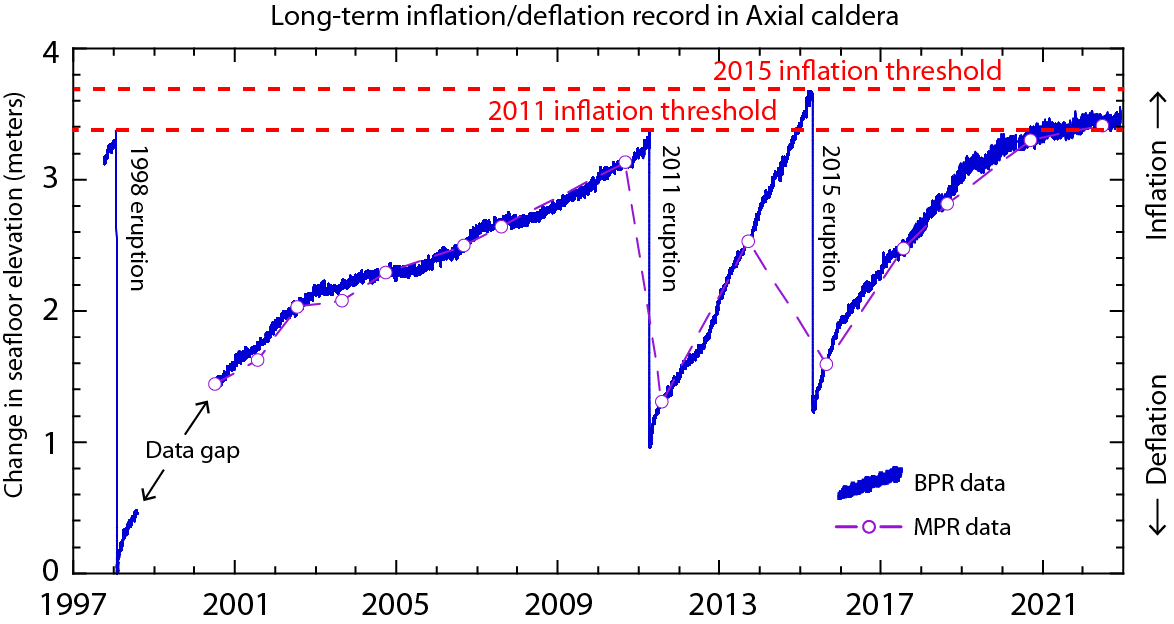
The plot below shows the same data, but focuses on the time period since 2010:
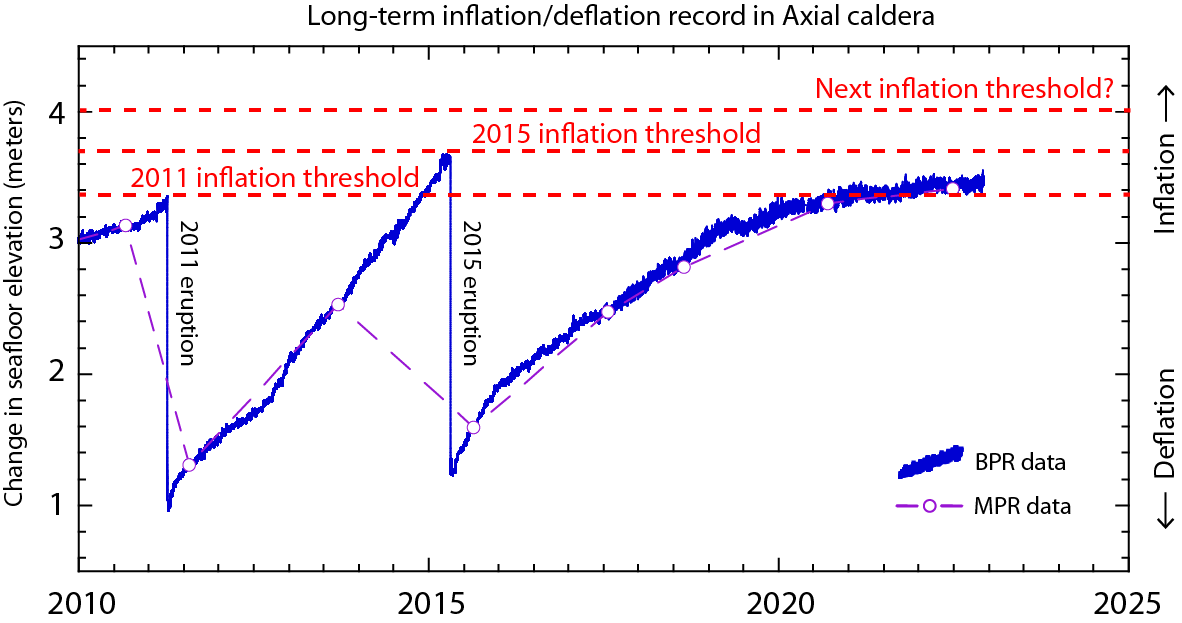
Blue curves are BPR pressure data measured at the center of Axial caldera. The purple dots are the campaign-style ROV-based MPR pressure measurements that are used to remove drift and tie the BPR dataset together. The red dashed lines show the level of inflation reached before the 2011 and 2015 eruptions. The threshold for the next eruption could be higher still (3rd dashed red line), since the current rate of seismicity is still very low.
January 5, 2022 - New paper published summarizing deformation and seismicity at Axial since 2015
A new paper summarizing the deformation and seismicity at Axial Seamount since its last eruption in 2015 has just been published in the journal Geochemistry, Geophysics, Geosystems. The paper is "open access" and is available for download at this web site: https://agupubs.onlinelibrary.wiley.com/doi/10.1029/2021GC010153
One surprising result from the paper is that, despite the highly variable rates of uplift and seismicity
since 2015 the number of earthquakes per day (or per meter of uplift) has increased exponentially in relation to the total uplift since the last eruption (see figure below).

This relationship, if repeatable from one eruption to the next, gives us another way to try to forecast the next eruption at Axial. Another interesting result from the paper is that the rate of inflation and magma supply since 1998 (blue and red curves in the plot below, respectively) have increased and decreased by about an order of magnitude (10 times), approximating a sinusoidal curve over a decadal time scale.

It is clear from this plot that there was a surge in magma supply between the 2011 and 2015 eruptions, but that the supply has been waning sharply since then. On the other hand, the suggestion of a long-term oscillation in magma supply presents the possibility that the rate of magma supply could increase again in the coming years.
December 30, 2021 - The decreasing rate of inflation since the 2015 eruption & implications for forecasting
Since the 2015 eruption, the rate of inflation at Axial Seamount has decreased by over an order of magnitude (over 10 times!). Soon after the eruption, the inflation rate was >100 cm/yr and now it is <10 cm/yr. This means the rate at which magma is being supplied to the shallow magma reservoir at the volcano has also drastically decreased. This has implications for our eruption forecasting.
When we first started this blog 10 years ago, our experience was that the rate of inflation had been relatively steady leading up to the 2011 eruption (~15 cm/yr), which made the kind of forecasting we are experimenting with here, based on extrapolating that steady rate into the future, seem feasible. Between the 2011 and 2015 eruptions, the rate of inflation was much higher (60-90 cm/yr), but it was still relatively steady, which enabled our successful forecast of the 2015 eruption. However, since the 2015 eruption, the rate of inflation has been decreasing rapidly, so our forecasted dates for reaching the 2015 inflation threshold have been progressively moving forward in time also. The UN-steady rate of inflation and the currently very low rates have frustrated our forecasting efforts.
Even though Axial has now reinflated 85-90% of the deflation it experienced in 2015, based on extrapolating the rate of inflation from the last six months, it still looks like the next eruption is 4-9 years away (2025-2030?), but obviously that time-window could change as the rate of inflation continues to change.
April 13, 2021 - Nevermind ... looks like the differential inflation rate is more reliable afterall.
A month ago, in my last blog entry, I noticed that while the differential uplift rate between stations MJ03F (central caldera) and MJ03E (eastern caldera) was quite low (3-4 cm/yr) and had been for months, the single-station uplift rate at MJ03F, recently showed a more robust rate of 20-30 cm/yr averaged over the last 3 months, and the other stations (MJ03D, E, B) showed similar rates. This made me speculate that, if real, the higher single-station rates might be evidence for a deeper source of deformation.
Well ... now a month later, that pattern has disappeared, and in fact has completely reversed itself! The current single-station uplift rates at MJ03F, D, E, & B are all slightly negative (indicating apparent subsidence), while the differential uplift rate between stations MJ03F-E is still the same at about positive 3-4 cm/year (indicating relative uplift at central caldera compared to eastern caldera).
From this, I conclude that the apparent pattern in the single-station uplift rates a month ago, and now, is primarily due to oceanographic and barotrophic effects (noise) - even in rates averaged over 3 months - rather than the real geophysical signals we are interested in (inflation or deflation of the volcano). The magnitude of the oceanographic noise can be ± 5 cm over weeks to months, and is spatially broad so it affects all the OOI stations almost equally. That is why they all appeared to be going up more than usual a month ago, and appear to all be going down more than usual now. Presumably, if the single-station rates were averaged over a longer period of time, or if the rate of real geophysical uplift was greater, then they would be more likely to be valid. The bottom line is that the differential uplift rate between stations MJ03F-E is still our best view of the magnitude of real geophysical inflation going on at Axial Seamount and how it changes with time.
For now, that is showing a relatively low rate of inflation (see Forecasting Method #4), which is consistent with the relatively low rate of seismicity at present (see William Wilcock's Axial seismicity webpage). Because of these very low inflation rates, the eruption forecast window is currently poorly constrained and I think needs to be pushed forward and broadened to 2025-2030 for now. We'll keep an eye on things and will narrow the forecast window back down if/when the inflation rate increases again.
March 12, 2021 - The rate of inflation is continuing to decrease ... or is it?
At the Fall Meeting of the American Geophysical Union in December 2020, I presented a talk in which I discussed that the forecast window was now 2022-2025, recognizing that the rate of inflation had continued to decrease since the 2015 eruption, effectively pushing our forecast window further into the future. Now, just a few months later I'm noticing something new: that our two ways of looking at the inflation rate are telling us two different things.
On our OOI inflation monitoring web site, I originally mainly tracked uplift at station MJ03F (central caldera), which is where we see the maximum uplift (and subsidence). We calculate the rate of uplift at all 4 OOI BOTPT instruments over the last 1 to 3 months on this inflation rates page. And we use the single-station uplift rate at MJ03F over the previous 3 months to extrapolate that rate into the future in our Forecasting Method #1. This seemed OK, but the uplift rate was a bit noisy due to non-geophysical sources of noise in the pressure data (including barotrophic, oceanographic, and tide residual noise).
So starting a few years ago, I began paying more attention to the differential uplift between stations MJ03F (central caldera) and MJ03E (eastern caldera) here
... because subtracting one from the other removed common sources of noise. It seemed like a cleaner view of the geophysical signal (volcanic inflation), and it seemed to work well because MJ03F consistently had the highest uplift rate and MJ03E had the lowest. And so I began using that differential uplift in Forecasting Methods #2, #3, and #4, using average differential uplift rates from the last 1, 3, and 6 months, respectively, to extrapolate into the future. Before now, my favorite was Forecasting Method #4.
But here's what I've noticed recently, which is making me question that: The differential uplift rate (F-E) is very very low, and has been since September 2020. Currently it is only 3-4 cm/yr, which is pushing the forecast dates far into the future (beyond 2026 at the moment, for Forecasting Method #4.
BUT, if I look at the current single-station uplift rate at MJ03F, it is a a much more robust 20-30 cm/yr, and the Method #1 forecast date is currently mid-2022. AND, if you look at the rates for the other OOI stations, THEY ALL HAVE SIMILAR RATES to MJ03F! So the reason the differential uplift rate (F-E) is currently so anemic is that both F and E are uplifting at similar (more robust) rates. In other words, the current pattern of uplift is BROADER than we have seen in the past. For example, a non-systematic look back at past uplift rates shows that most of the time the rate at F has been about 1.5-2 times greater than at E, but currently it is 1.1 times greater (and all 4 stations have a similar uplift rate, which is unusual). A broader pattern of uplift (if real) presumably means a DEEPER pressure source.
• Looking at the plots of how the single-station uplift rates have varied with time, shows that the non-center stations (MJ03E, D, B) have more variable rates than the center station (F), so it's possible that this is just a quirky artifact of the current rates, and this apparent situation will pass and doesn't really mean much (the single-station uplift rates are noisy, afterall). But if it is real, then this could signal that the magma supply system at Axial is evolving in some interesting ways, and that what we throught was the best forecasting method (#4), may not be, and that perhaps our original single-station method (#1) may be better, at least at the moment. We will have to watch carefully how things proceed from here! What is still true, regardless, is that the rate of inflation has decreased significantly since the 2015 eruption (see long-term plot below).
July 15, 2020 - Changing eruption forecast windows due to changing inflation rate
It is now clear that the rate of inflation changed significantly around May 2019. Before that time, the rate of inflation was averaging around 30 cm/yr at the Caldera Center (or 20 cm/yr in our differential inflation rate), and since then it has decreased to about half that rate. Here is how our thinking has evolved during this time:
• In summer 2019, it looked like the forecast window was between 2020-2022 (this is what we put in an abstract submitted to the 2019 AGU Fall Meeting). However, that was right after the decrease in inflation rate, so this fact was not yet clear, nor how long it would last.
• By the AGU Fall Meeting in December 2019, we could see that the inflation rate had slowed significantly, so on the poster we presented at AGU, we expanded the forecast window to 2020-2024, but it was clear that the latter half of that window was more likely than the first half.
• Now in summer 2020, we can see that the average rate of inflation is staying at that lower rate, and if it stays that way, we won't reach the 2015 inflation threshold until late in 2022, so now the forecast window looks like it's between 2022-2025. Of course that could change again if the rate of inflation either increases or decreases further. We will try to narrow the forecast window as we get closer.
• So far, comparing our 4 experimental methods for forecasting using the OOI inflation data (HERE), we are liking Forecasting Method #4 the best, which averages the recent rate of inflation over the longest time interval (6 months). The lastest plots from that forecasting method are displayed below (these updated daily, based on the latest OOI data).
We anticipate that the final eruption forecast window will be 1-2 years wide and will start when we reach the 2015 inflation threshold, but it appears we're still a few years away from that yet.
February 18, 2020 - New Forecast Plots - Method #4
Today we are starting a FOURTH alternative method of forecasting the time when Axial Seamount will reach the inflation level reached before the 2015 eruption started. The main difference between Forecasting - Method #3,and Method #4 is that in this one we are averaging the rate of uplift over the last 6 months (instead of 3 months for Method #3). We use the 6-month inflation rate to extrapolate into the future to when the differential level of inflation will reach: (1) the level when the 2015 eruption started, and (2) a level 20 cm higher than in 2015. We will continue to compare the forecast dates predicted by the four different methods before making a more formal eruption forecast later. Note, the forecast plots below are static examples, but they are updated once a day using the latest data from the OOI Cabled Array -> here.
December 5, 2019 - Axial Seamount re-inflation & forecast update
The plot below has now been updated with data from the OOI Cabled Array through early-December 2019. As you can see, since May 2019 there has been an abrupt decrease in the rate of inflation at Axial Seamount, and this has pushed back the forecast window for the next eruption. A year ago it appeared the forecast window was between 2020-2022, but now we are widening our forecast window to 2020-2024, because of uncertainty in the rate of inflation (and whether it will remain low or will revert to a higher rate). Nevertheless, Axial has now re-inflated almost 2.0m (or~80%) of the 2.5m that it deflated during the 2015 eruption. The inflation forecast pages HERE use the latest data from the OOI Cabled Array to make daily updates to the forecast of when Axial will be re-inflated to the 2015 level, using several different methods. We will attempt to narrow our eruption forecast window as we get closer to that threshold.
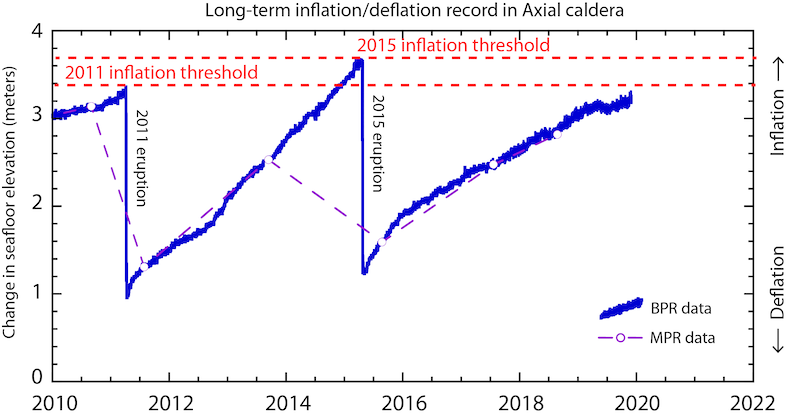 |
| Plot of the long-term time-series of inflation/deflation at the center of Axial Caldera, updated through January 2018. Blue curves are BPR pressure data measured at the center of Axial caldera. The purple dots are the campaign-style ROV-based pressure measurements that are used to remove drift and tie the BPR dataset together. The red dashed line shows the level of inflation reached before the 2011 eruption. |
December 26, 2018 - Axial Seamount re-inflation update
The plot below has been updated with data from the OOI Cabled Array through late-December 2018. We have added two inflation threshold lines: one from the 2011 eruption and one from the 2015 eruption. At the current rate of uplift, Axial will be re-inflated to the level it reached before the 2015 eruption in mid-2020. However, it is possible (likely?) that it will have to re-inflate above that value before the next eruption starts, as it did in 2015, extending the eruption time window into mid 2021. We are not yet ready to make a specific eruption forecast, but you can follow the real-time re-inflation data from the OOI Cabled Array -> HERE.
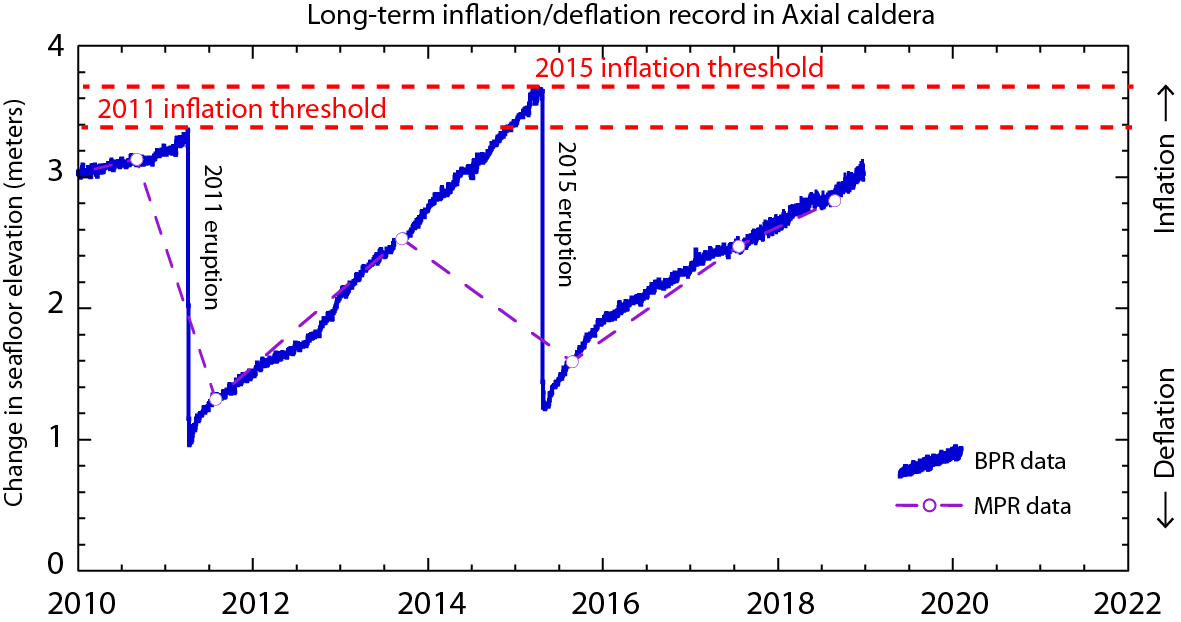 |
| Plot of the long-term time-series of inflation/deflation at the center of Axial Caldera, updated through January 2018. Blue curves are BPR pressure data measured at the center of Axial caldera. The purple dots are the campaign-style ROV-based pressure measurements that are used to remove drift and tie the BPR dataset together. The red dashed line shows the level of inflation reached before the 2011 eruption. |
November 26, 2018 - New Forecast Plots - Method #3
This is a third alternative method of forecasting the time when Axial Seamount will reach the inflation level reached before the 2015 eruption started. We have found that Forecasting Method #1 and Forecasting Method #2 have not been ideal, so we are trying a third. Method #1 is "noisy" because the de-tided BPR depths include tidal residuals and oceanographic effects; it uses an average rate of uplift from the last 12 weeks. In contrast, Method #2 uses DEPTH DIFFERENCES between two stations (removing the source of noise in #1) to calculate a differential inflation rate, but it only used an average rate of uplift from the last 4 weeks. This was better, but the time-period for averaging the rate of uplift seems to be too short, so in Forecasting Method #3, we are averaging the rate of uplift over the last 12 weeks. Hopefully that will give us the best of both worlds. We use the average inflation rate for the last 12-weeks to extrapolate into the future to when the differential level of inflation will reach: (1) the level when the 2015 eruption started, and (2) a level 20 cm higher than in 2015 (which is somewhat arbitrary, but is included because the level of inflation in 2015 was higher than the level reached before the 2011 eruption). These plots are updated once a day using the latest data from the OOI Cabled Array. The forecast plots below are static examples, but they are updated once a day using the latest data from the OOI Cabled Array -> here.
August 30, 2018 - New Forecast Plots - Method #2
We have found that the Forecasting Method #1 that we introduced in the previous post is not ideal, because it is quite "noisy" and therefore the forecast dates are too varible. Therefore, we are trying a new Forecasting Method #2 that uses DEPTH DIFFERENCES between two BPR stations to calculate a differential inflation rate. This method appears to be better because it removes the tidal residuals and oceanographic effects that are common to both stations and highlights the geophysical signal (volcanic inflation) that we are interested in. We calculate the differential inflation rate for the last 4-weeks and use it to extrapolate into the future to when the differential level of inflation will reach the same level it reached before the 2015 eruption. The forecast plots below are static but are updated once a day using the latest data from the OOI Cabled Array -> here.
May 4, 2018 - New Forecast Plots - Method #1
We have added a new web page with Forecast Plots to our real-time OOI data site -> HERE. The Forecast Plots below were generated on April 29, 2018, but these plots will be updated daily at the link above. The plots use the average rate of inflation from the last 12 weeks to calculate the time when Axial Seamount will reach the level of inflation when the 2015 eruption started. Of course, we do not know at exactly what level of inflation the next eruption at Axial will be triggered, but our best guess is that it will be within a year after the 2015 threshold is reached. We will likely make a more specific forecast when we get closer to that threshold. Keep in mind that the rate of inflation can change with time.
January 12, 2018 - Axial Seamount re-inflation update
Axial Seamount has now re-inflated about 1.4 m since the 2015 eruption, which is about 55% of the 2.54 m of deflation that occurred during the eruption. The plot below has been updated with data from the OOI Cabled Array through mid-January 2018. Note the increase in the rate of uplift in the second half of 2017 (to the right of the latest purple dot) compared to the first half of 2017. The current rate of uplift is about 35-40 cm/yr. If that rate continues, it will take another 3-4 years until Axial is re-inflated to the level it reached before the 2015 eruption. We are not yet ready to make a specific eruption forecast, but you can follow the real-time re-inflation data from the OOI Cabled Array -> HERE.
 |
| Plot of the long-term time-series of inflation/deflation at the center of Axial Caldera, updated through January 2018. Blue curves are BPR pressure data measured at the center of Axial caldera. The purple dots are the campaign-style ROV-based pressure measurements that are used to remove drift and tie the BPR dataset together. The red dashed line shows the level of inflation reached before the 2011 eruption. |
September 14, 2017 - Axial Seamount has now recovered half of the deflation from the 2015 eruption
Our latest field work at Axial Seamount was on R/V Revelle with ROV Jason and AUV Sentry, July 13-23, 2017 (check out our cruise blog HERE). Our latest pressure measurements show that Axial has now re-inflated about 1.25 m since the last eruption in April 2015. That is half of the 2.5 m of deflation that occurred during that eruption. However, as you can see from the plot below, the rate of re-inflation has also slowed during that time. If the current rate of inflation continues, then the next eruption will not occur before 2020. A more specific forecast will depend on how the inflation rate evolves over the next few years. We will be following the continuing re-inflation using plots of the real-time data from the OOI Cabled Array -> HERE.
 |
| Plot of the long-term time-series of inflation/deflation at the center of Axial Caldera, updated through July 2017. Blue curves are BPR pressure data measured at the center of Axial caldera. The purple dots are the campaign-style ROV-based pressure measurements that are used to remove drift and tie the BPR dataset together. The red dashed line shows the level of inflation reached before the 2011 eruption. |
December 15, 2016 - Three companion papers published on the 2015 eruption at Axial Seamount
Three papers were published in Science and Geophysical Research Letters about the 2015 eruption at Axial Seamount, including our successful eruption forecast. The April 2015 eruption occurred within our 12-month forecast window (calendar year 2015). The figure below is from one of the papers (Nooner and Chadwick, 2016), showing our updated time-series of inflation and deflation at the center of Axial caldera through May 2016. It shows that the volcano inflated about 30 cm higher before the 2015 eruption, compared with the previous eruption in 2011. It also shows the volcano deflated 2.4 m during the 2015 eruption and immediately started re-inflating. Real-time deformation data from the OOI Cabled Array is displayed on a separate web page: HERE.
The three recently published papers are:
Nooner, S. L., and W. W. Chadwick, Jr. (2016), Inflation-predictable behavior and co-eruption deformation at Axial Seamount, Science, 354(6318), 1399-1403, doi:10.1126/science.aah4666.
Wilcock, W. S. D., M. Tolstoy, F. Waldhauser, C. Garcia, Y. J. Tan, D. R. Bohnenstiehl, J. Caplan-Auerbach, R. P. Dziak, A. F. Arnulf, and M. E. Mann (2016), Seismic constraints on caldera dynamics from the 2015 Axial Seamount eruption, Science, 354(6318), 1395-1399, doi:10.1126/science.aah5563.
Chadwick, W. W., Jr., B. P. Paduan, D. A. Clague, B. M. Dreyer, S. G. Merle, A. M. Bobbitt, D. W. Caress, B. Philip, D. S. Kelley, and S. L. Nooner (2016), Voluminous eruption from a zoned magma body after an increase in supply rate at Axial Seamount, Geophys. Res. Lett., 43, 12,063–012,070, doi:10.1002/2016GL071327.
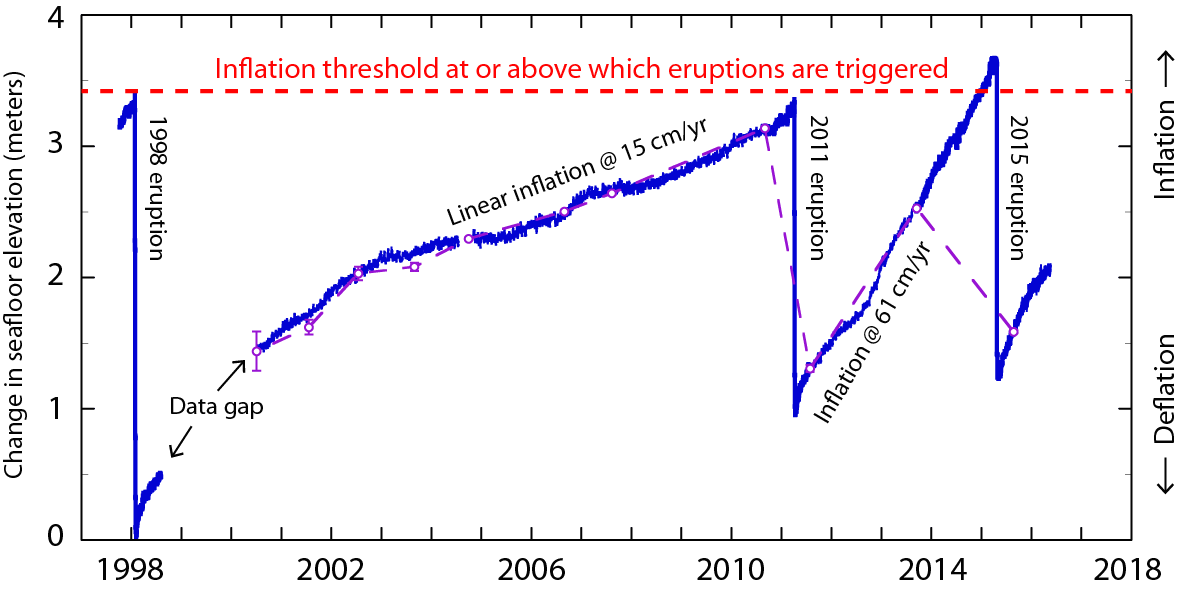 |
| Plot of the long-term time-series of inflation/deflation at the center of Axial Caldera, updated through May 2016 (Nooner & Chadwick, 2016) |
August 10, 2015 - New lava flows at Axial Seamount are confirmed
In late July, the University of Washington OOI Cabled Array group was able to collect mulitbeam sonar data and make one ROV dive that confirmed that new lava flows were indeed erupted at Axial Seamount in April-May. We will be going on another expedition to Axial Seamount August 14-29 with the ROV Jason and AUV Sentry on board R/V Thompson to explore and sample these new lava flows, and to collect data to continue the time-series of volcanic deformation on which the successful 2015 eruption forecast was made. You can follow the cruise blog HERE. Our next focus will be: When's the next eruption? The data we collect will help us answer that question.
April 30, 2015 - It looks like an eruption
The temperature data from the bottom pressure/tilt instruments are showing increases that suggest that lava was erupted on the seafloor somewhere nearby. Check out the latest data HERE. Below is the same long-term inflation/deflation plot as below, but now with the 2015 eruption added. Note however, that I've just eyeballed it in a vertical sense (on the Y-axis). Until we go out in August and repeat our ROV-based pressure measurements (the purple dots), we won't know exactly where it fits, nor the drift of the OOI pressure sensor. But I don't think this is too far off. See the OSU Press Release HERE.
 |
| Plot of the long-term time-series of inflation/deflation at the center of Axial Caldera on which the 2015 forecast was based, updated with the 2015 eruption in orange (using OOI Cabled Array data). |
April 24, 2015 - Intrusion / eruption (?) event at Axial Seamount
There was a major seismic/deformation event at Axial Seamount on 23-24 April 2015. Thousands of earthquakes and sudden ground deformation (subsidence of 2.4 m over the first 3 days) were detected by the instruments on the OOI Cabled Array. The event definitely involved an intrusion of magma into the upper south rift zone (probably a dike), but it is not yet clear if there was also an eruption of lava onto the seafloor. Apparently, no lava was erupted in the summit caldera where the OOI cabled observatory instruments are located, because they all survived and there are no obvious temperature anomalies (yet). It's still possible that lava erupted either north or south of the caldera along one of the rift zones, but we won't know if that happened until a ship can get out there to look (probably not until late May at the earliest, but definitely by mid-July). Real-time seismic data from the OOI cabled observatory are being posted by William Wilcock HERE, and bottom pressure/tilt data are being posted HERE. There was an Axial Seamount science planning workshop 20-22 April in Seattle and the meeting web site has more information about this event. This is the event that we forecast last fall to occur sometime in 2015, so it's very exciting that it actually happened! We will have an expedition to Axial in mid-August to repeat our campaign-style pressure measurements to update the time-series below.
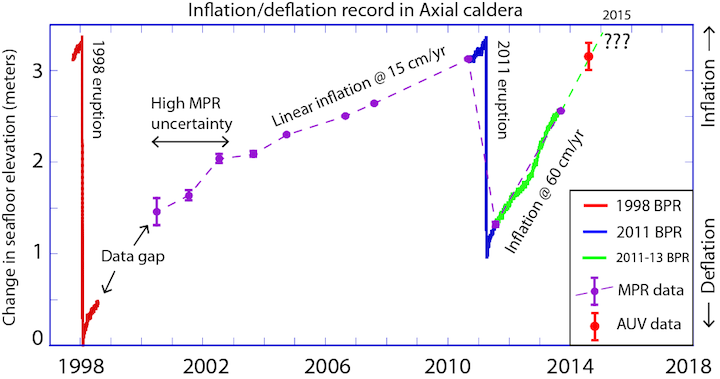 |
| Plot of the long-term time-series of inflation/deflation at the center of Axial Caldera on which the 2015 forecast was based, presented at the NOVAE Workshop, 20 April 2015. |
October 2014 to April 2015 - Other public presentations of the 2015 Axial Eruption Forecast
Other public presentations of the 2015 Axial eruption forecast were made on the following dates:
October 9, 2014: "Forecasting eruptions at Axial Seamount", presented at the Hatfield Marine Science Center fall seminar series, Newport, OR.
February 10, 2015: "Forecasting eruptions at Axial Seamount", presented at NOAA Headquarters, Silver Spring, MD, as part of the OneNOAA Science Seminar Series.
April 20, 2015: "Axial Inflation - Past, Present, and Future", presented at the NOVAE Workshop ("Axial Volcano - Wired and Restless - A Gathering to Explore Two Decades of Scientific Potential"), Seattle, WA. A video recording of this talk is available on the NOVAE web site HERE.
October 1, 2014 - Near-real-time data from the Ocean Observatories Initiative's (OOI) cabled observatory
The Ocean Observatories Initiative (OOI) has deployed a cabled observatory in the NE Pacific called the Regional Scale Nodes (RSN), which includes monitoring instruments in the caldera of Axial Seamount. The RSN is funded by the National Science Foundation (NSF) and is operated by the University of Washington. Some of the monitoring instruments in Axial Caldera include bottom pressure/ tilt instruments to provide near-real-time data on the ground deformation occurring there. The instruments were turned on in early September 2014. We will provide updates on those monitoring data here when the data become publically available. We may see precursory signals leading up to the next eruption, or in any case, we will certainly know if and when an eruption has occurred.
September 24, 2014 - Slide from a talk at the Monterey Bay Aquarium Research Institute (MBARI)
In August 2014, the MBARI mapping AUV (autonomous underwater vehicle) used its multibeam sonar to resurvey lines across Axial caldera that it previously ran in August 2011. A comparison of the two surveys found depth changes between 2011-2014 amounting to ~1.8 m of apparent uplift at the caldera center (the MBARI AUV data were collected and analyzed by Dave Caress). That is consistent with a continuation of the uplift rate of ~60 cm/yr that we found in our 2011-2013 pressure resurvey (see plot below), suggesting the high uplift rates appear to have continued into 2013-2014. If we add the AUV resurvey data to our BPR/MPR pressure time-series at the caldera center, it appears that Axial will have fully re-inflated (to the level just before the 2011 eruption) by the end of 2014, suggesting it might be ready to erupt again within the next year. So our new forecast is for the next eruption at Axial to occur between now and the end of 2015.
 |
| Plot of inflation/deflation at the center of Axial Caldera with MBARI AUV datapoint added from an August 2014 resurvey. |
September 17, 2013 - Email from sea to NSF (edited slightly for clarity and brevity)
We would like to share with you some exciting results from our September 2013 expedition to Axial Seamount. We’ve been out here on R/V Thompson making dives with ROV Jason for the last two weeks and are just finishing up. Our work consisted of seafloor pressure measurements to document Axial’s volcanic inflation/deflation cycle, particularly since its 2011 eruption. We redeployed three bottom pressure recorders (BPRs), replacing one that was buried by the 2011 lava flows. We installed six new benchmarks total—two to replace two that were buried by the 2011 eruption and four to expand our coverage and tie our network to the OOI/RSN nodes. We then made ROV-based campaign-style pressure measurements (with a mobile pressure recorder, or MPR) on our array of seafloor benchmarks and downloaded data from our continuously recording bottom pressure recorders.
Here are some of our new results, which are quite surprising and unexpected to us:
1) The post-2011 eruption inflation rate is higher than we expected to see. We measured 1.22 m of uplift since August 2011, totaling 1.57 m of reinflation since the April 2011 eruption! This is an average uplift rate of 61 cm/yr!!! For comparison, during most of the period between the 1998 and 2011 eruptions, we saw steady inflation at only 15 cm/yr.
2) In addition, based on our previous models, we expected to see a gradually decreasing rate of uplift since 2011. Instead, there was an almost a doubling in the inflation rate in September 2012, recorded on both of the BPRs that were in place during 2011-2013.
3) Overall, this means that Axial has already recovered 65% of the -2.4 m of deflation that we measured during the 2011 eruption. If this inflation rate continues, it will be back to its pre-2011 level of inflation within only another year and a half (by January 2015)!
4) We don’t really know what this means in terms of forecasting the next eruption, but an inescapable conclusion is that the inflation rate since 2011 has been higher than we’ve ever measured, and this may imply that the next eruption could come sooner rather than later. Obviously, this has important implications for the OOI/RSN cabled observatory at Axial, which is not yet operational.
We hope you agree that these results are exciting. They seem to indicate that Axial’s magma supply rate has significantly increased since 2011. We feel these results also show that it is important to keep this time-series going, because it is still providing new insights and surprises, it will allow us to document the post-eruption reinflation phase for the first time, and it will provide invaluable context for the OOI/RSN observatory. As always, thanks for your interest and support of this project.
(The 2013 expedition to Axial Seamount was funded by the National Science Foundation, NOAA, and the US Navy).
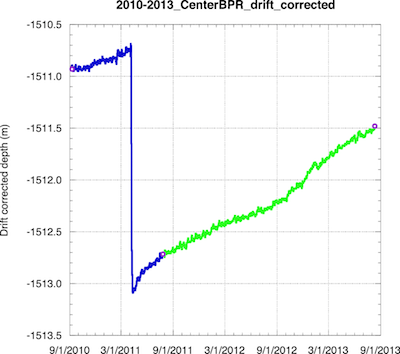 |
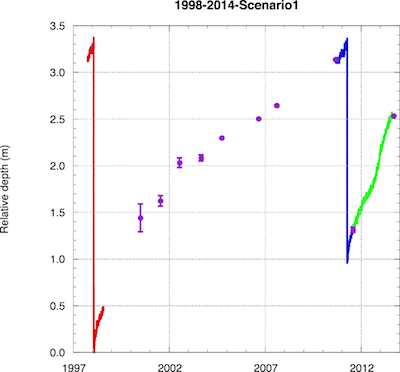 |
| The first attached figure shows drift-corrected bottom pressure recorder (BPR) data from September 2010-September 2013, with the co-eruption deflation in blue and the post-eruption reinflation in green. ROV-based pressure measurements with a mobile pressure recorder (MPR), used to constrain BPR drift, are in purple. | The second figure shows the entire time-series from 1997-2013. The red curve shows the deflation during the 1998 eruption, the blue curve is the deflation during the 2011 eruption, and the purple dots are our campaign-style inflation measurements. This puts our new BPR data (in green) into the longer-term context. |
July 2012 - Paper published in Nature Geosciences
The following text is from a paper published in July 2012 in Nature Geoscience:
(Chadwick, W. W., Jr., S. L. Nooner, D. A. Butterfield, and M. D. Lilley (2012), Seafloor deformation and forecasts of the April 2011 eruption at Axial Seamount, Nature Geosci., 5(7), 474-477, doi:10.1038/NGEO1464.)
Now with the first documented eruption cycle at Axial, we look ahead and attempt to forecast the next event, but still with the ambiguity owing to the 1998–2000 data gap. If we assume that the cycle is time-predictable and the 1998 and 2011 eruptions both occurred at the same level of inflation, the next eruption would be expected in 2018 (left figure below). This would be 7 years between eruptions, shorter than the 13-year recurrence interval between 1998 and 2011, because the deflation in 2011 was smaller than in 1998. The other end-member possibility is that the pattern is volume-predictable. In this case, the timing of the next eruption would not be predictable, but the volume of magma removed from the summit reservoir would be, based on the time since the last eruption. For example, an eruption in 7 years would be smaller in volume than the last two, an eruption equal in size to 2011 could recur in 13 years, but one the size of the 1998 eruption would not occur until 2029 (right figure below).
We hypothesize that the pattern at Axial may be more predictable than at volcanoes on land, as its location at a spreading center means that the underlying crust is thin and it probably has a more direct, steady and simple magma supply system... We will be able to test these hypotheses by continuing geodetic monitoring at Axial, particularly once a regional cabled observatory is established as part of the Ocean Observatories Initiative.
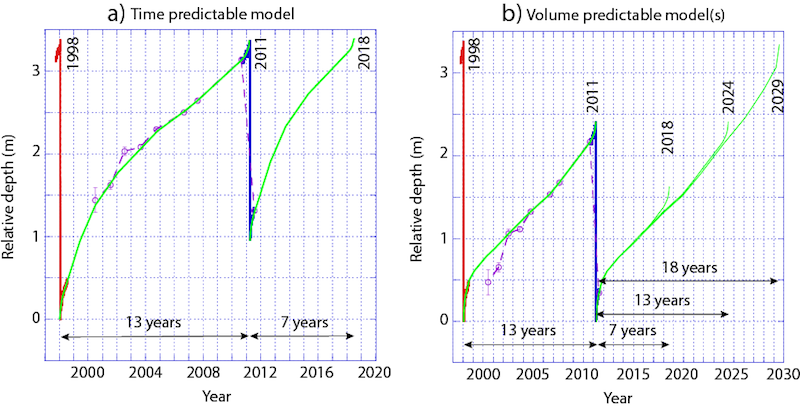 |
| Two forecast scenarios for the next eruption at Axial Seamount, based on the cycle of inflation and deflation. In both, the inter-eruption MPR data (purple dots) are coregistered with the 2011 center BPR data (blue), but their exact relationship (in relative depth) to the 1998 BPR data (red) is unknown. (a) Time-predictable model in which eruptions (deflations) are triggered at a critical level of inflation and the next eruption at Axial would be expected in 2018. (b) Volume-predictable model in which the volume of the next eruption is predictable based on the time since the last one, but the date it will occur is unknown. (from Figure 3 of Chadwick et al., 2012) |

